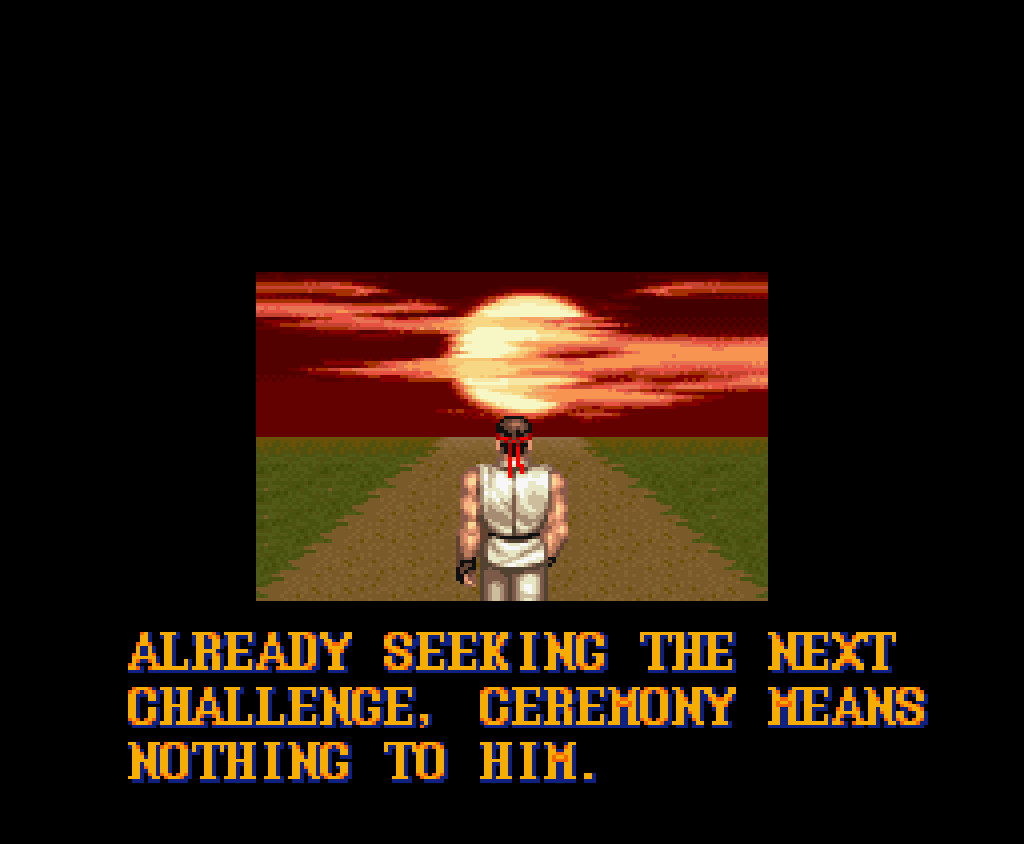Super Nintendo History

Introduction
Oh, the game market… Different from any other market, the video game market is peculiar in a way: it don’t follow companies, trends or traditions.
Of course, there are the fanboys, but they are a tiny portion. Gamers, by consequence the market, follows just one king: the good games. And this creates and destroys empires.
We saw Atari going from heaven to hell in the same generation, Nintendo dominating the 8 bits market overwhelmingly, suffering and turning the table in 16 bits, the newcomer Sony dominating for 2 generations in a row. Then, again, Nintendo dominating with Wii, which next saw a commercial failure with WiiU. Now, in current days, we have the Switch sold out for months, when some specialists said it was dead even before the release.
But, back to the Nintendo 16 bits giant, what makes it to be the most wanted console in the retrogamer market? Why is it considered by several gamers the best console in history? What makes it deserve a so special place in the nostalgic heart of gamers from the 90ths?
Here are several reasons:
- Hardware ahead of the competition. Unlike any other generation (including current ones), during the
16 bitsNintendo fought with the best hardware. Launched after the competitors, Nintendo innovated to worry not only with the CPU, but with a very optimized pack. TheSNES, aside to use a CPU that handles the same games as the competitors using a clock speed below that some of them, brought new effects that were arcade exclusive until that time:mode 7(responsible for image rotation) andzoom. To have an idea about this achievement, theSegaCDaddon (released one year later by Sega) required two7.5MHzCPUs to do whatSNESwas able with only a3.5MHzone. Additionally,SNESvideo processor was able to produce much more colors, it had more RAM then competitors, produce bigger and more number of sprites, and one of the most remarkable points: its sound chip (the famousS-SMP), designed and produced by Sony, with audio quality close to the CD players (something still not known by most of the public), being able to receive games with orchestrated sound tracks, or reproduce clear voices.
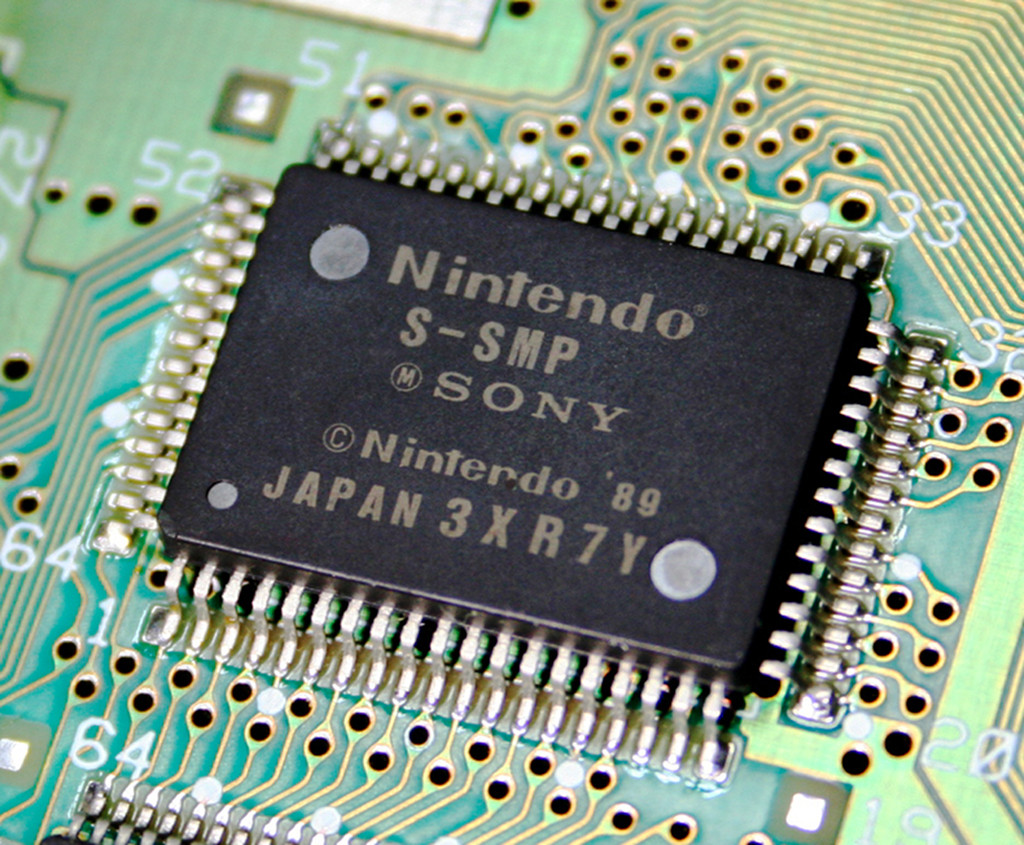 The S-SMP chip (by Yaca2671)
The S-SMP chip (by Yaca2671)
-
Strong third parties support. Like any of its consoles, Nintendo produced perfect games, and those were often the
SNESthe best sellers ranking. But unlike any of its follow generations, games from other companies made great performance in the console. And, most of the times, in their best shape, even being able to face Nintendo own games. Which other console, in the history, received so good and antagonistic games like Mario and Mortal Kombat 2, by example? Not to mention excellent ports from several arcade games, like Street Fighter, Turtles in Time, and several others. -
Iconic gamepad. If for the Nintendo
8 bits, Nintendo innovated introducing the gamepad, for theSNESthe company introduced a gamepad that became the industry pattern since them (to not say blatantly copied): a cross shaped flawless directional, 4 buttons disposed in a friendly way, and the brand new shoulder buttons (LandR).
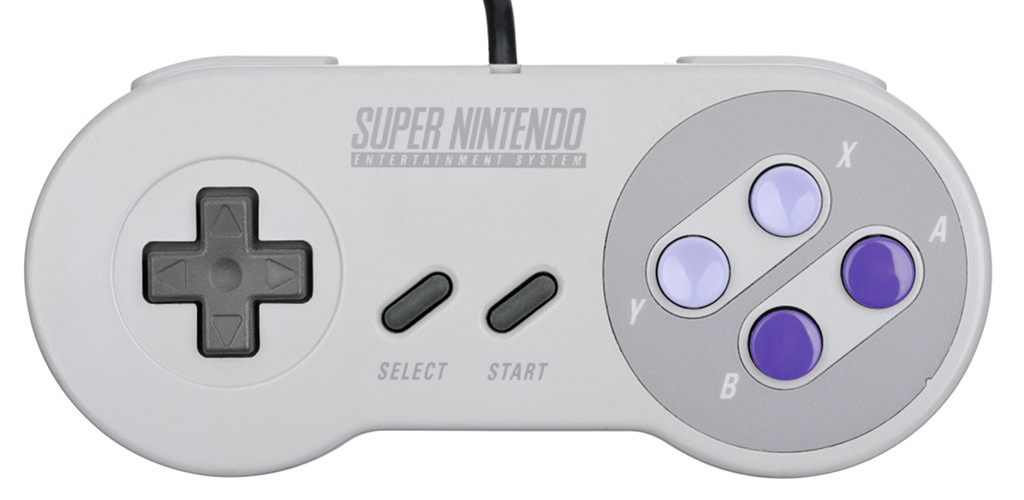 As known as “little bone”
As known as “little bone”
-
Franchises started or consolidated in the console.
SNESstarted some franchises that delivered some awesome games (some of them even in current days), likeMario Kart,Donkey Kong,StarFox, and consolidated others, likeSuper Metroid(which was a huge improvement when compared with its predecessor). Additionally some iconic games that appeared only inSNES, likeChrono Trigger, considered by several players one of the best games of all times. During that generation, more than compete only with hardware, Nintendo didn’t loose its market share because they answered each competitor move with new games. Mario games were not more able to attract players? No problem, Nintendo created a brand new franchise, likeDonkey Kong. -
Nintendo abandoned its childish image. Due the strong competition, Nintendo not only allowed violent games being published in the console, but the company itself released games like
Killer Instinct. For some reason, after theSNES, Nintendo got back to the childish image (mainly in the next consoles,Nintendo 64andGamecube).
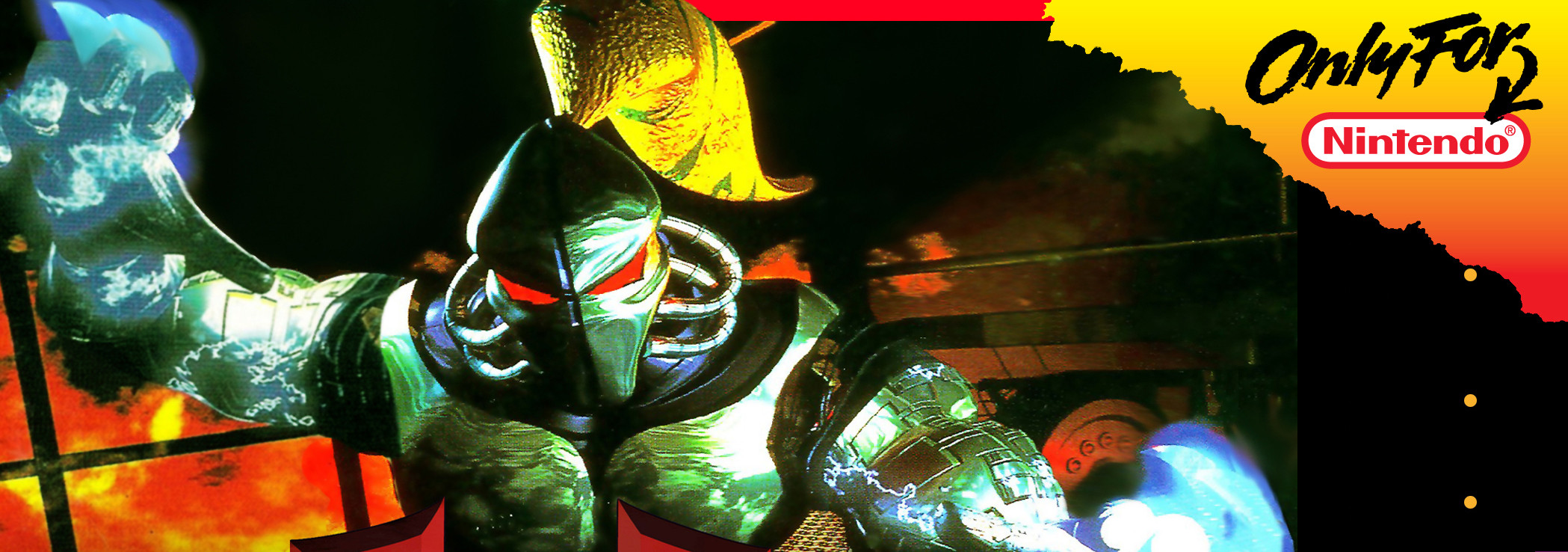 Killer Instinct
Killer Instinct
-
Hardware pushed to the limits. While the competition used expensive addons to try to make technically better games, Nintendo pushed
SNESto the limit, publishing games using polygonal rendering (likeStarFox), games created in Silicon Graphics64 bitsgraphical workstations (likeDonkey Kong) or games ported from the next generation, likeStreet Fighter Alpha 2. -
Strong competition. All the above would not happen in a so extreme way if Nintendo didn’t face, for the first time, a strong competitor (Sega). While it happened only in USA (in Japan or rest of the world, Genesis never achieved the same success), Sega, in its best sales performance reached a bit more than a half of the
16 bitmarket share, using strong marketing and trying to attach a monotonous image to Nintendo. Additionally, consider the fact that USA was (and still is) the strongest video game market. Of course, marketing alone would not be able to produce results with bad a product: Sega produced several good games that perfectly fit the north american tasting. Several good sports games starring local idols (there is a story saying that most part of the Joe Montana richness came from Sega), violent games (forbidden by Nintendo until that time), massive support from Eletronic Arts (that never loved Nintendo) and the Genesis price subsiding (i.e., put the price so low as possible, or, sometimes, below the production costs). Sega even sold its console with their best game of that time (Sonic). This subsiding politics, years later, lead to the company left the hardware market (with Dreamcast). Nintendo, facing this aggressive competition, learned how to fight back; aside thePlayItLoud!campaign, Nintendo countered with what really matters in the game world: producing awesome games. For this reason, the16 bitsgeneration was known asConsole Wars(we even had a book about it).
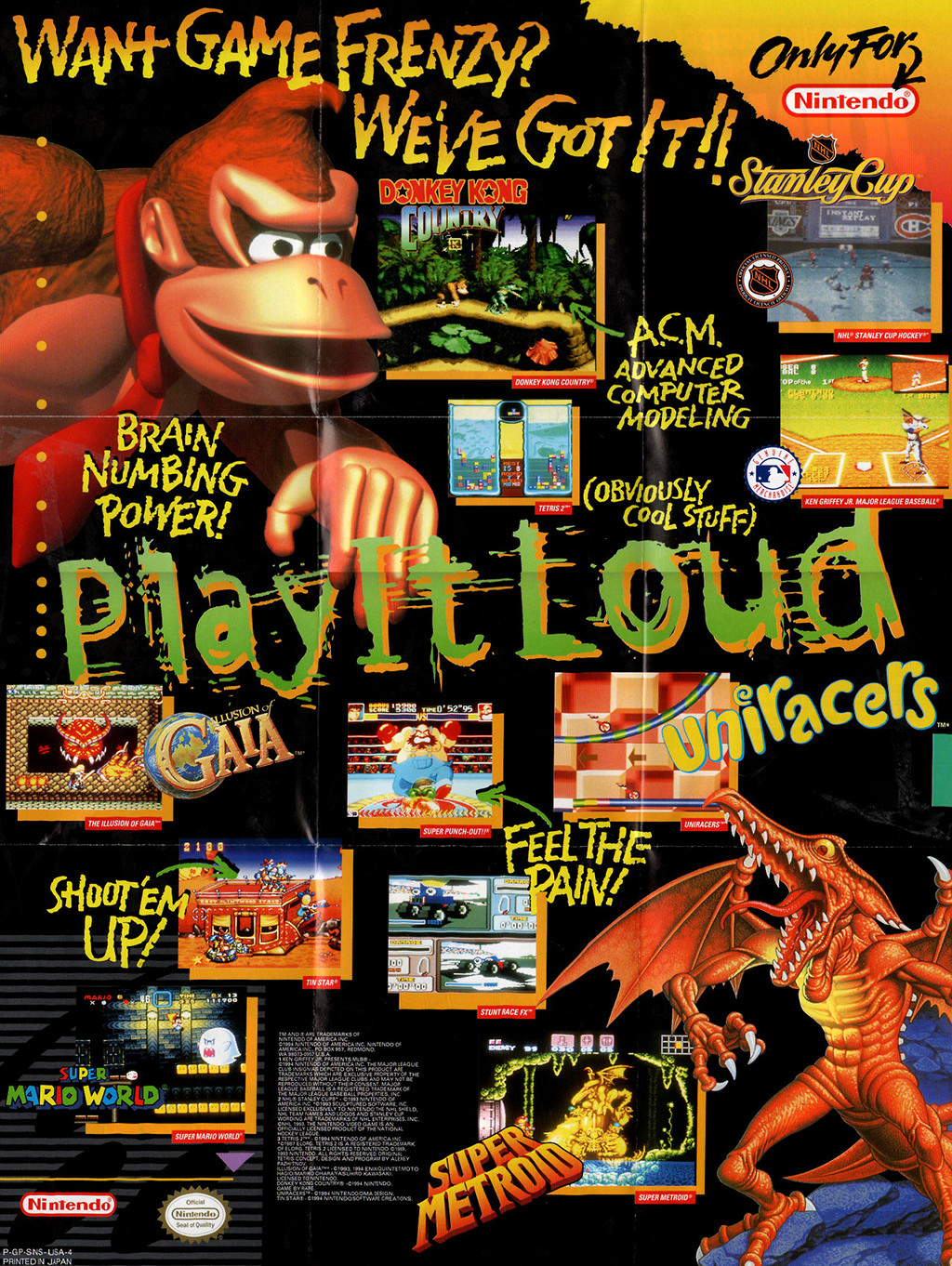 “PlayItLoud!” campaign flyer
“PlayItLoud!” campaign flyer
The Beginning
End of 80ths: after save the gaming market, Nintendo dominates gaming in an overwhelming way. And that’s not just exaggeration: in 1988, the NES cartridge market in the United States alone was larger than the entire computer market. In Japan, according the specialists, at 1989, 37% of the homes had a NES, while in the USA, 30%.
The US Senate even opened an investigation, claiming that “Japanese computers” were a national sovereignty threat.
Facing such a scenario, Nintendo did not seem concerned about the competition, and the NES successor was not in a hurry to be announced.
Meanwhile, the competition changed tactics: instead of competing with the NES, they decided to move into a new generation. NEC launched, during 1987, the PC Engine in Japan, and Sega launched the Mega Drive at 1988. Based on the 16-bit architecture, both offered sounds and graphics far superior to the NES.
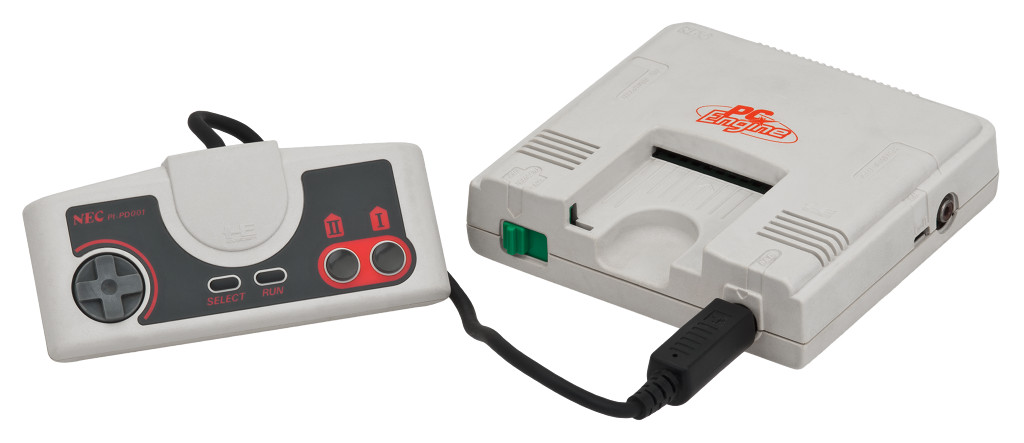 PC Engine from NEC (by Evan-Amos)
PC Engine from NEC (by Evan-Amos)
The PC Engine release was quite successful in Japan to the point of selling more than the NES in its launching year. In the next year (1988), the console innovated to be the first video game to receive a CD-ROM player as addon, again facing good sales in Japanese lands.
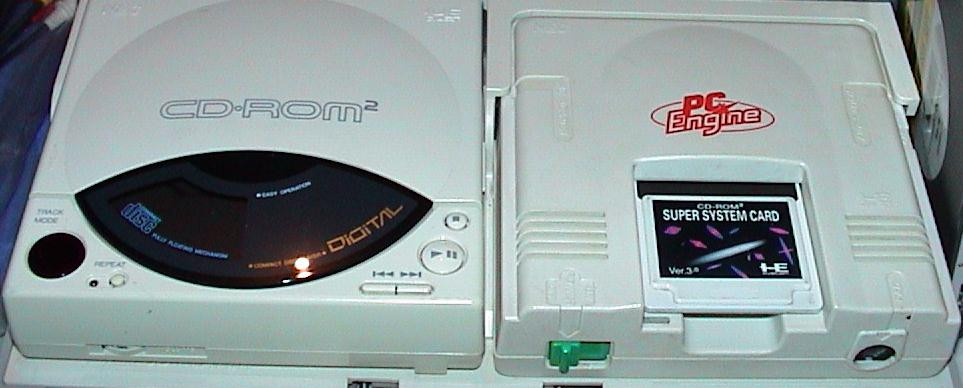 The PC Engine addon: CD-ROM²
The PC Engine addon: CD-ROM²
Nintendo then switched on the warning signal, announced the Famicom (the Japanese version of the NES) successor in 1988. The initial prototypes of the console, shown in Famicom Tsushin Magazine in December 1988, contained backward compatibility with Famicom and a headphone jack on the side (with volume control, similar to Genesis).
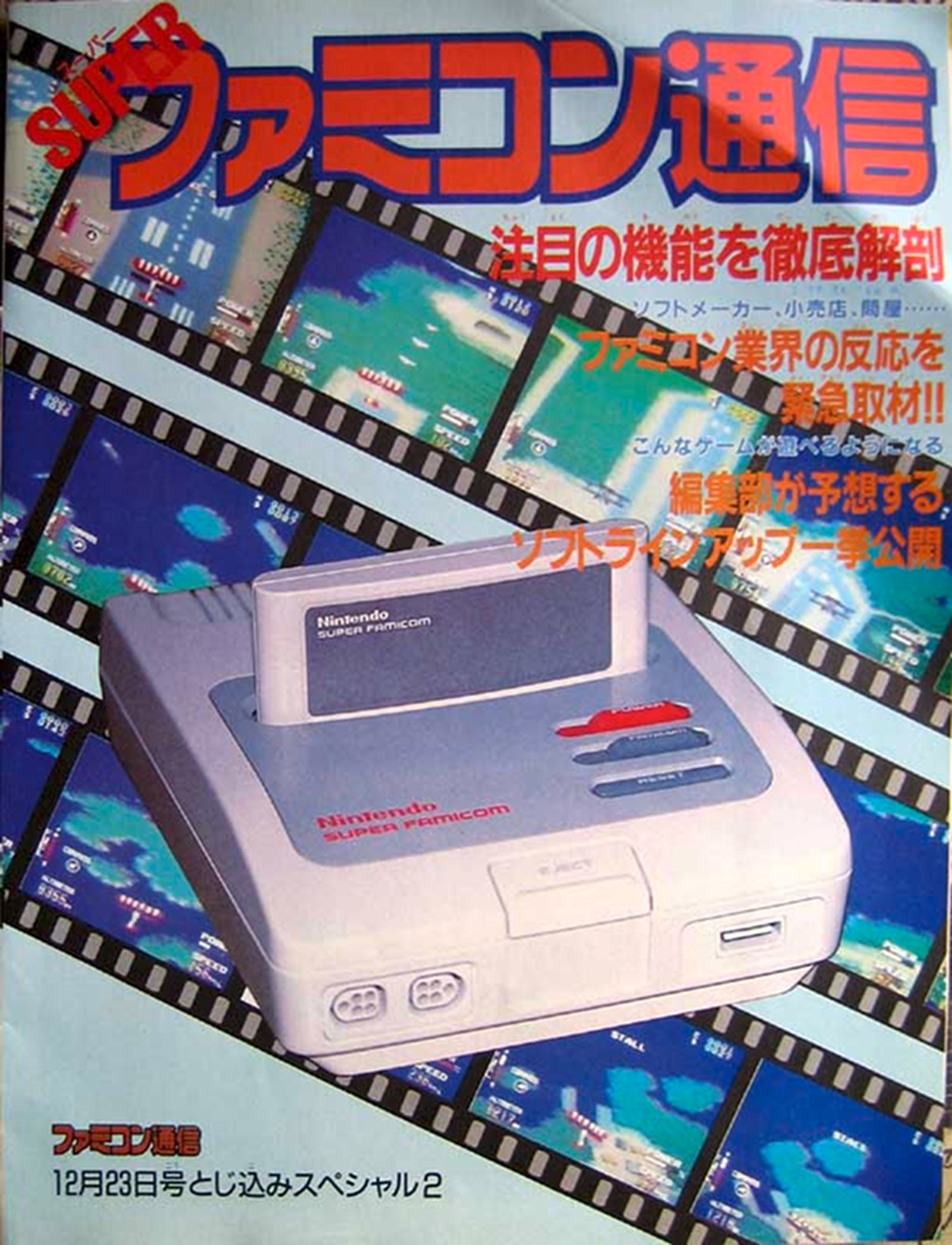 Super Famicom prototype: Power, Famicom and Reset buttons (Famicom Tsushin Magazine, Dec/88)
Super Famicom prototype: Power, Famicom and Reset buttons (Famicom Tsushin Magazine, Dec/88)
The control was already presenting its shape very close to the production version, although it used the Famicom connector and buttons with names (A, B, C and D) and different colors (buttons all in orange).
The second prototype, showing in June 1989, already removed the backward compatibility, but still showed the headphone jack (removed in the final version).
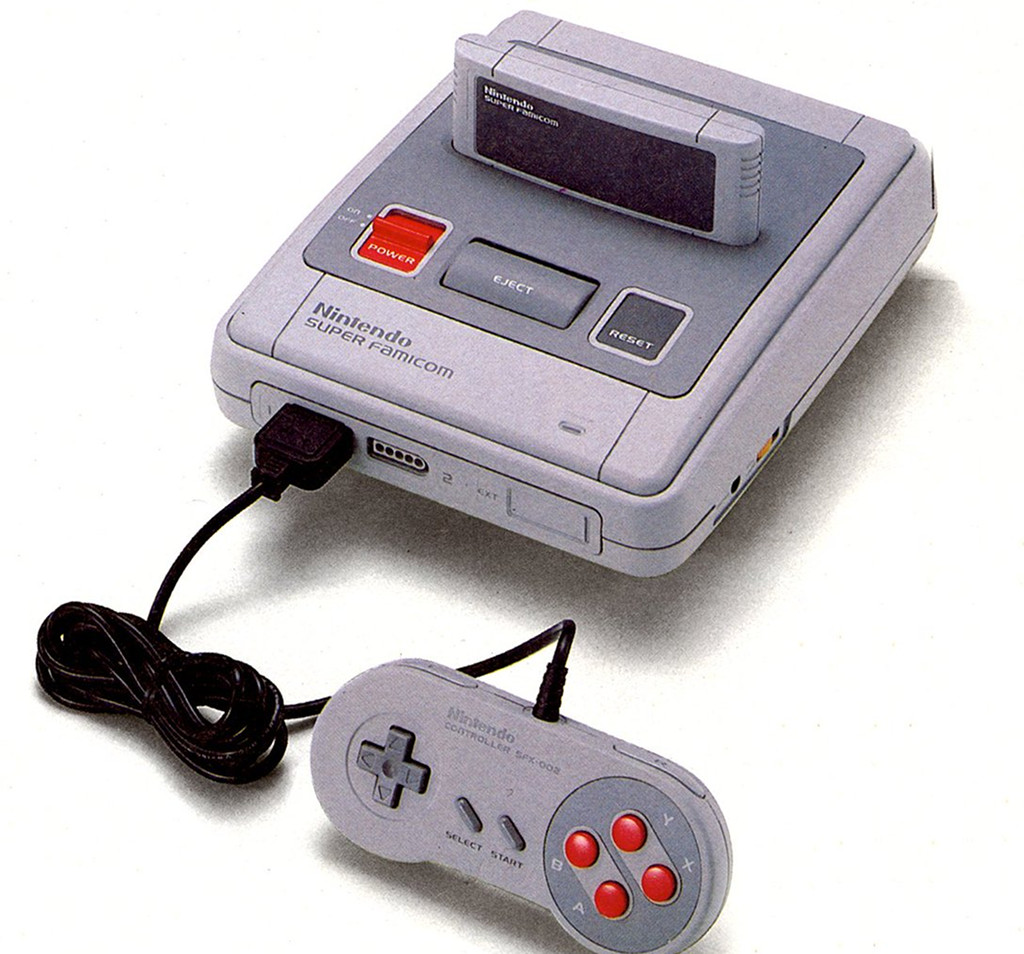 Second Super Famicom prototype: no backward compatibility
Second Super Famicom prototype: no backward compatibility
The Japanese launch (which included Super Mario World and F-Zero) had a 300,000 units stockpile shipped at undisclosed hours during the night: there were rumors that Yakuza, the famous Japanese mafia, planned to intercept the charge. The launch was made on November, 21, 1990, a Wednesday. The Japanese were already in long queues long before the stores opened, but the move nevertheless caused such a mess in the country that officials urged Japanese manufacturers to launch new consoles only during the weekends.
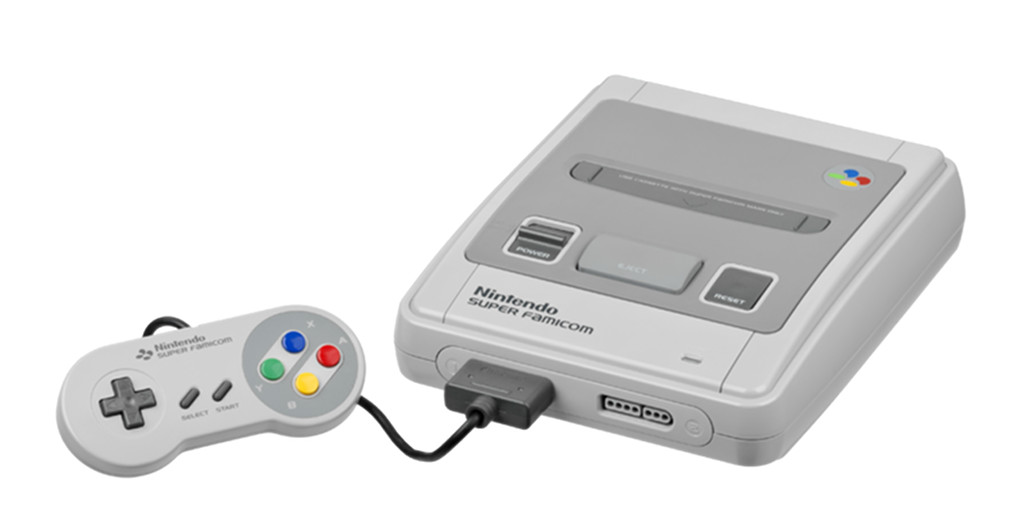 Super Famicom in its final shape (by Evan-Amos)
Super Famicom in its final shape (by Evan-Amos)
In the USA
Both NEC and Sega launched their systems in the US in 1989, renamed to TurboGrafx-16 and Sega Genesis, respectively. NEC was the one who worried Nintendo due its success in Japan.
But NEC American subsidiary made some mistakes: it took them a long time to launch the console on American territory (as they thought the original design would not please Americans), made a campaign publicizing it as a direct competitor to the NES and packed it with a game totally unknown to American public. The console, in a short time, was shipwrecked in the country.
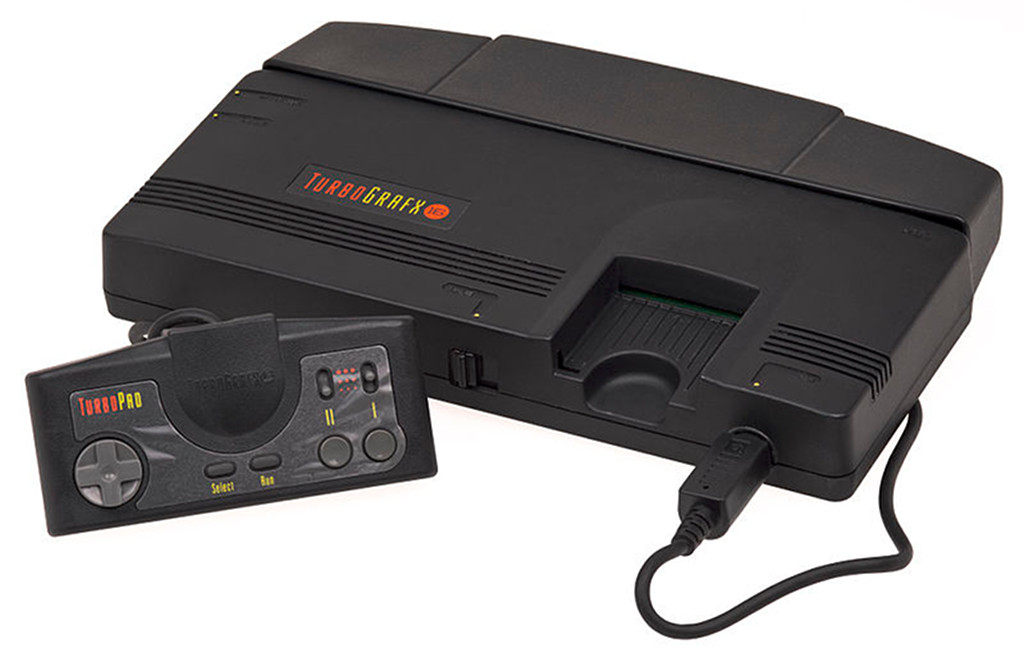 American PC-Engine: the TurboGrafx-16
American PC-Engine: the TurboGrafx-16
Sega was able to release the Sega Genesis two months earlier than NEC, using the same marketing idea that NEC used in Japan: announcing Genesis as the first 16 bits console. Included in the pack was a known arcade game, Altered Beast. If it was not enough to make the console sales reach the sky, it was enough to make it gain some traction and not suffer from the same unhappy sin as TurboGrafx-16.
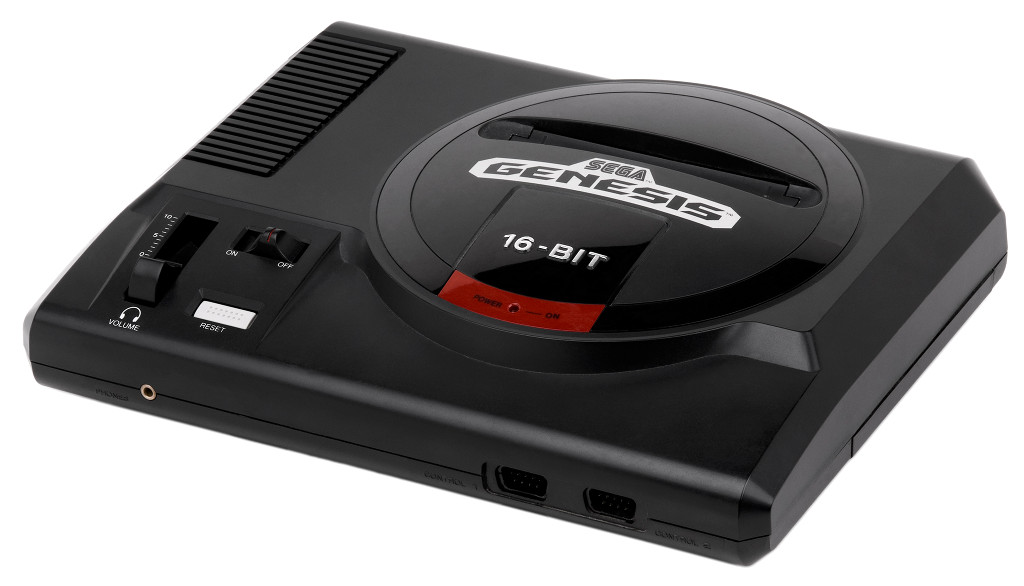 Sega didn’t spend time redesigning Mega Drive: this is the Sega Genesis
Sega didn’t spend time redesigning Mega Drive: this is the Sega Genesis
Facing this friendly scenario (no strong 16 bits competitor yet), Nintendo was not in a hurry to release its new console in the USA, and it was more concerned about redesign it to the USA market. The new design was given to the same responsible for redesign the Famicon to the USA, Lance Barr, the NoA (Nintendo of America) industrial designer.
Quoting his words:
The Super Famicom was maybe okay for the market in Japan. For the US, I felt that it was too soft and had no edge. We were always looking at future modular components (even the NES had a connector on the bottom), so you had to design with the idea of stacking on top of other components. I though the Super Famicom didn’t look good when stacked and even by itself, had a kind of “bag of bread” look.
If that statement was made in today’s globalized and politically correct world would cause tremendous discomfort among Nintendo subsidiaries.
Also, when Lance Barr talks about stacking the console on top of other components, read CD-ROM reader: at that time, after the uproar caused by NEC in Japan, all manufacturers were open to the possibility of launching a CD peripheral to their consoles.
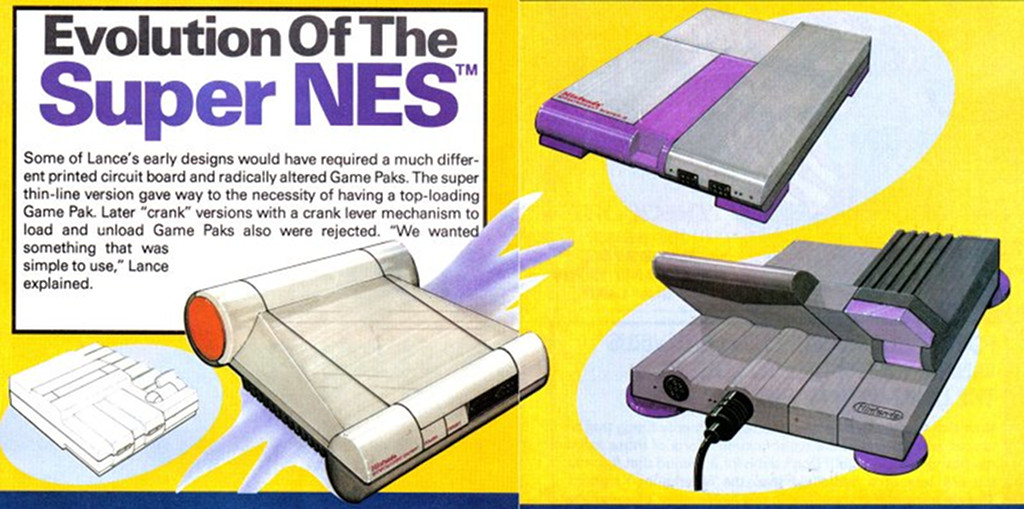 Lance Barr prototypes for SNES before the final design (Nintendo Power, Jun/91)
Lance Barr prototypes for SNES before the final design (Nintendo Power, Jun/91)
1990: Sega raises…
In its previous console, Sega made several mistakes in the American market: the Master System was never launched directly by the company there (it was released by a toy manufacturer and advertised as such), arrived several years after the absolute domination of the NES, and at the time it did not have games of great appeal to the American public.
Launching Genesis before the competition, releasing it as a next generation video game and with some best-selling arcade games, Sega had a reasonable success. Very different from the previous generation.
As a result, Sega decided to invest heavily in the US market, opening several offices in the country, hiring hundreds of developers, formed partnerships with sports stars and creating heavy marketing campaigns against NES (the famous Genesis does what Nintendon't).
Genesis does what Nintendon’t
This was something that caused some confusion at Nintendo: for the Japaneses, culturally, attacking the rival directly so was a offense, and not well seen. For the Americans, it was something that showed attitude.
In addition to marketing, games like Joe Montana, Moonwalker (from then-greatest pop star Michael Jackson), and a number of Electronic Arts games fell to American tastes. Not to mention that still in 1991, the console received Sonic, which was a sales phenomenon in the country.
Electronic Arts was releasing its games only in Genesis: Nintendo had a clause that, until then, had forbidden companies producing games for its consoles to launch the same game on another systems for 2 years. EA, in the previous generation, even stated that NES was dead and would never release games to him. The company’s shareholders, following the phenomenal growth of the 8-bit console, required the company to release its games to the console, which was done reluctantly. So when Sega released Genesis in the US, there was the company’s opportunity to support a Nintendo rival.
1991: Super Nintendo arrives in America
After Sega finally opened the eyes of Nintendo of America, the console had a pre-launch, with few units available, on August 23, 1991, for $ 199, packaged with Super Mario World. Other games available were F-Zero and Pilotwings (which featured mode 7), as well as SimCity and Gradius III.
Then it was finally released nationwide at 9 September 1991.
Its former partners were, during the year 1991, launching games that later became classics of the system, such as Final Fight, Super R-Type, Actraiser, Final Fantasy II and Super Ghouls n' Ghosts.
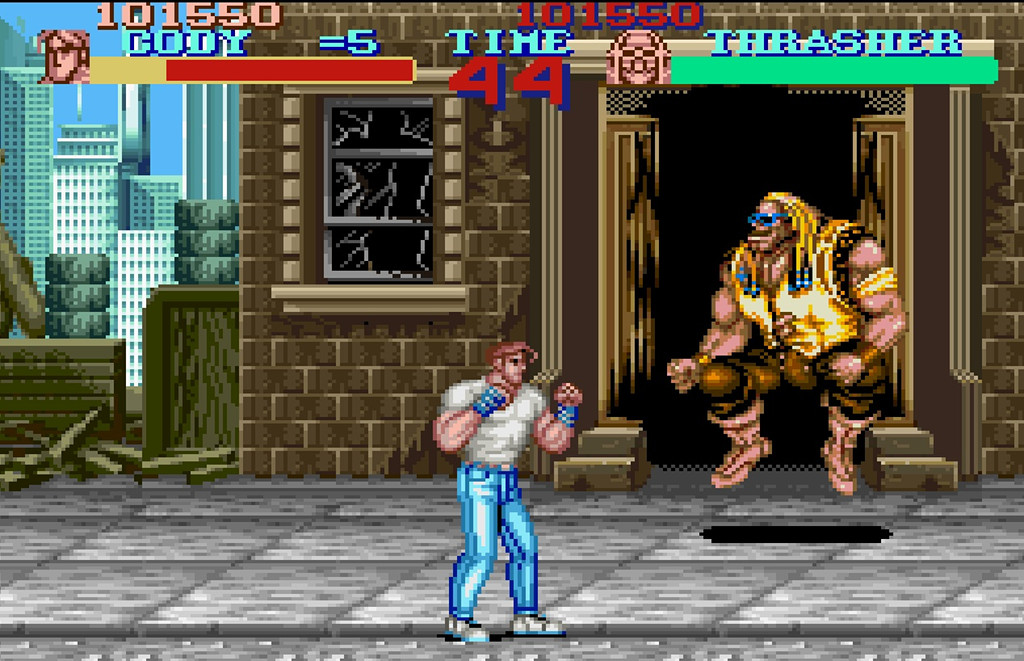 Final Fight port
Final Fight port
In Japan, the system enjoyed absolute dominance, but in the United States the company saw the market attention divided with the competition. Genesis received games that particularly appealed to the American public. Games like Road Rash (illegal motorcycle racing game, where opponents could swap punches and kicks on motorbikes) Spiderman vs. the Kingpin (fairly well-known to comics) added up to the announcement of a CD-ROM that would be released soon.
Add to that more aggressive Sega marketing that its console was much more cool than the rival:
Sonic advertisement on TV
But then something changed everything…
The Street Fighter 2 phenomenon
In early 1991 Capcom released Street Fighter 2 for arcades, a game that quickly became a worldwide fever. Several reasons for: the game established a new standard for the fighting genre versus and technically was far ahead of any game until then. Big characters with 6 buttons for punching and kicking, various special moves, each with its extremely detailed and fully movement scenarios, many digitized voices, endings for each character, 4 bosses!
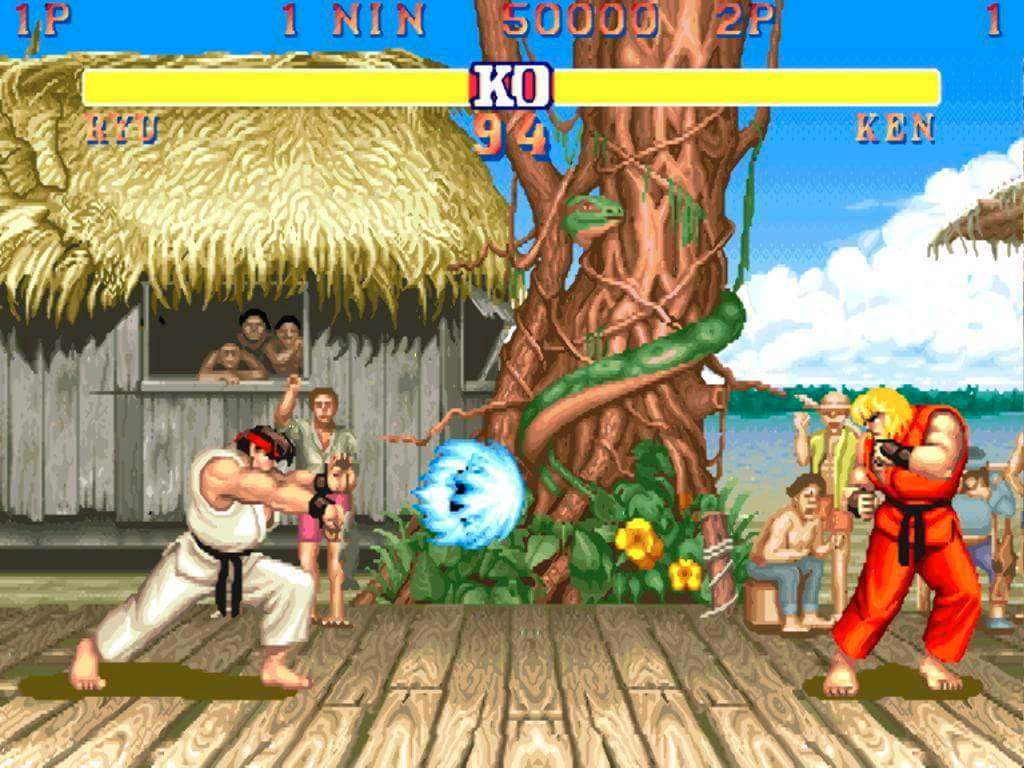 Street Fighter 2 on arcades: too ahead of its time!
Street Fighter 2 on arcades: too ahead of its time!
Several countries started to see arcades of Street Fighter 2 in all the corners. Malls, bars, stationery, road (who forgets the pirate versions?), even in residential quarters it was possible to find the arcade.
Then, at the end of 1991, Capcom announces in Japan to be developing a version of the game for Super Nintendo! The gamers and the market were incredulous: since the 16 bits were still in their infancy and the games still had a lot to evolve, many doubted that any console could run the game satisfactorily. In fact, players still thought Street Fighter 2 belonged to a different generation of hardware, and that a port for any 16-bit video game was almost impossible.
The game was released in Japan only in June 1992, and did not disappoint: with 16 Mb (the biggest cartridge of 16 bits until then), the game was all there! The 8 playable characters, the 4 bosses, all the scenarios, moves and endings!
The control, until then the only console with a 6-button control, fell like a glove: all movements were present and the answer was quick as in the arcades!
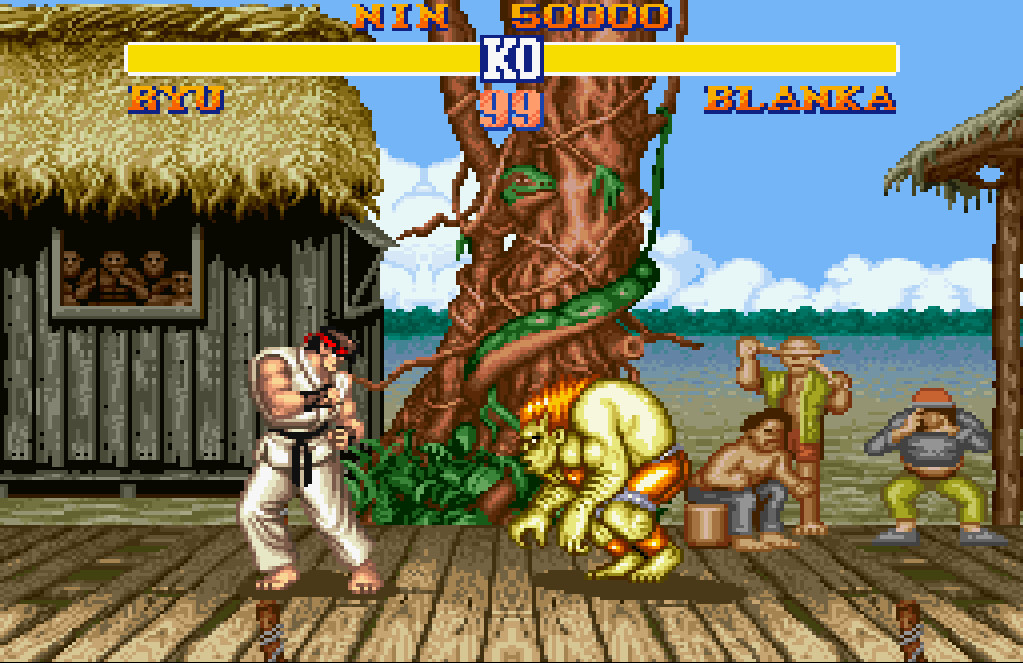 Street Fighter 2: the Super Nintendo port
Street Fighter 2: the Super Nintendo port
Curiously, the characters voices were accelerated or slowed down according to the spell force (a weak hadouken had a slow pronunciation, a strong hadouken had a quick pronunciation). But the soundtrack was not only adapted from the arcades: it was entirely redone by harnessing the S-SMP audio power. Tracks like Ken’s scenario have gained new life in Super Nintendo!
Of course, the conversion had few drawbacks: some backgrounds cuts (like an elephant missing on either side of the Dhalsim background and palm trees missing from the Sagat one), the bonus stage of burning oil barrels was replaced by a brick wall breaking, and some voices were suppressed. But those were small details that did not detract from the game port: at that time the arcade ports used to suffer huge downgrades. In fact, the port was considered the best adaptation of an arcade so far.
The Japanese launch faced huge lines at the stores, and the game sold out in less than an hour. In the first two weeks of sales, the game sold more than 1 million units, even at the exorbitant price (for the time) of $99 (when converting from yen to dollar). The few resellers who got one of the first copies resold the game for $150.
At the following month the game was released in the USA and in the rest of the world. And changed the video games history forever: the search for a Super Nintendo raised a way that made the time between 1992 and 1993 the best SNES sales period. I.e., people bought a SNES only to play Street Fighter 2.
For all above reasons, this game is the only non Nintendo game in the top 5 best sellers for the console, at 5th position. For Capcom, it’s more important than that: its their sales record for one version of any game, until current days!
In several countries, many people get aware about Super Nintendo, at that time an expensive console, after watch Street Fighter 2 in videogame rental stores, where you can rent the console paying by played time.
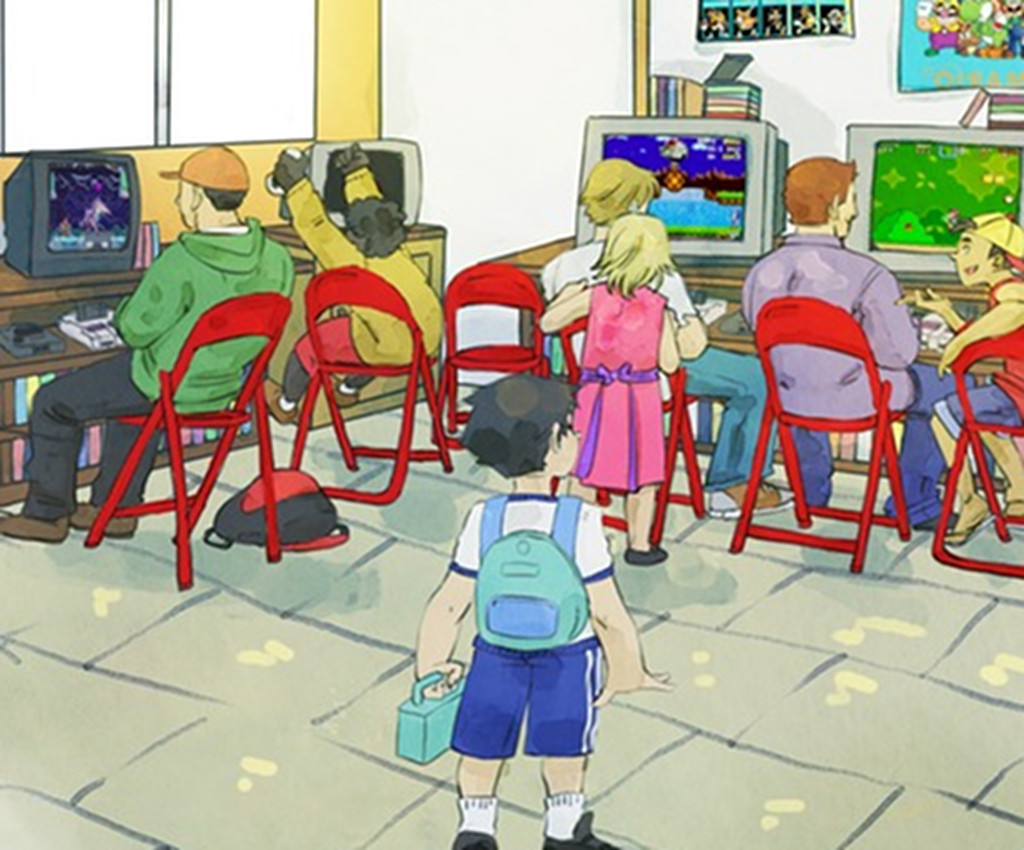 Videogame rental stores: how people get aware of the SNES in several countries (ilustration for the Brazilian book
Videogame rental stores: how people get aware of the SNES in several countries (ilustration for the Brazilian book Videogame Locadora)
1992: The competition became more intense
Sega, after started to see its market sharing decrease, started to counterattack: launched its CD reader, SegaCD in the USA (after a failure launching in Japan, with only 4 mediocre games), announced not only a Street Fighter 2 port, but several sequences for its famous games, including Sonic.
At the end of that period, Sonic 2 kept the Sega side still strong, but some internal problems started to come to the surface. SegaCD, by example, was developed in an isolated way in Japan (i.e, without consulting its most lucrative subsidiary, Sega of America). As result, the addon was launched without solve one of the Genesis problems (few colors palette), and too expensive. Disagreement between the 2 subsidiaries got more proeminent in Sonic 2: Yuki Naja, the Sonic creator, traveled to the USA to develop the game, saying the atmosphere in Sega of Japan was disturbing.
In the meanwhile, SNES received several good games: Super Contra II, Alien 3, Batman Returns, The Legend of Zelda: A Link to Past (considered by several gamers the best of the console), and another fantastic arcade port, Turtles in Time.
Can you not get excited about this song?
Nintendo promised to release a CD-ROM addon too, which would be not only more powerful than SegaCD, but cheapest too. The company CEO, Hiroshi Yamauchi, said it was best wait until the technology get more mature with games that would justify the extra cost.
At this time, Nintendo released a game that presented several versions in the next consoles: Mario Kart. Initially considered a toy game by the critics, the game was not only the 4th most sold game in the console: it started a franchise that today is considered the Nintendo main one, selling even more than Mario solo games in current consoles.
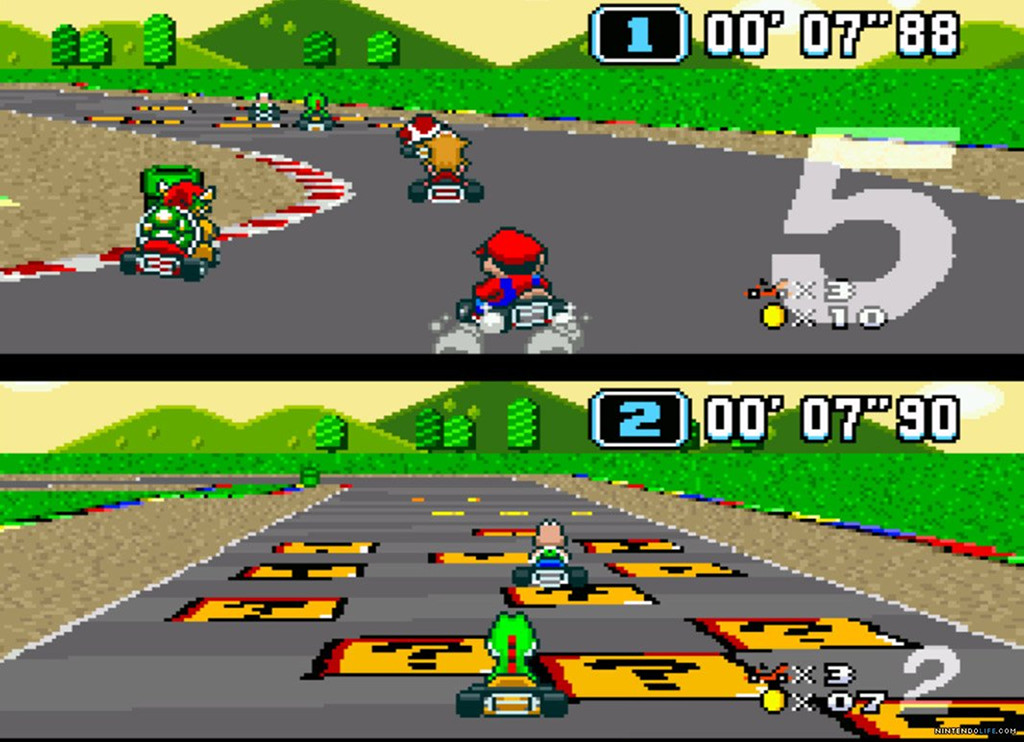 Super Mario Kart abusing zoom and rotation effects
Super Mario Kart abusing zoom and rotation effects
This version focus was in the racing, with the items in a second place. In the following versions, driving skills lost its focus to the items, which raised complains from some fans.
1993-1994: Rules and corporate image changing
Since 1992, Nintendo relaxed its third-parties policy: now they can release the same game in the competitors, without wait for 2 years.
With this, one year later after SNES received its version of Street Fighter 2, Genesis received a port too, with a brand new 6 buttons controller, to allow an arcade experience. While the port was much anticipated, it was obfuscated by the SNES port of Street Fighter 2 Turbo one month earlier, in August 1993, with better colors, music and voices.
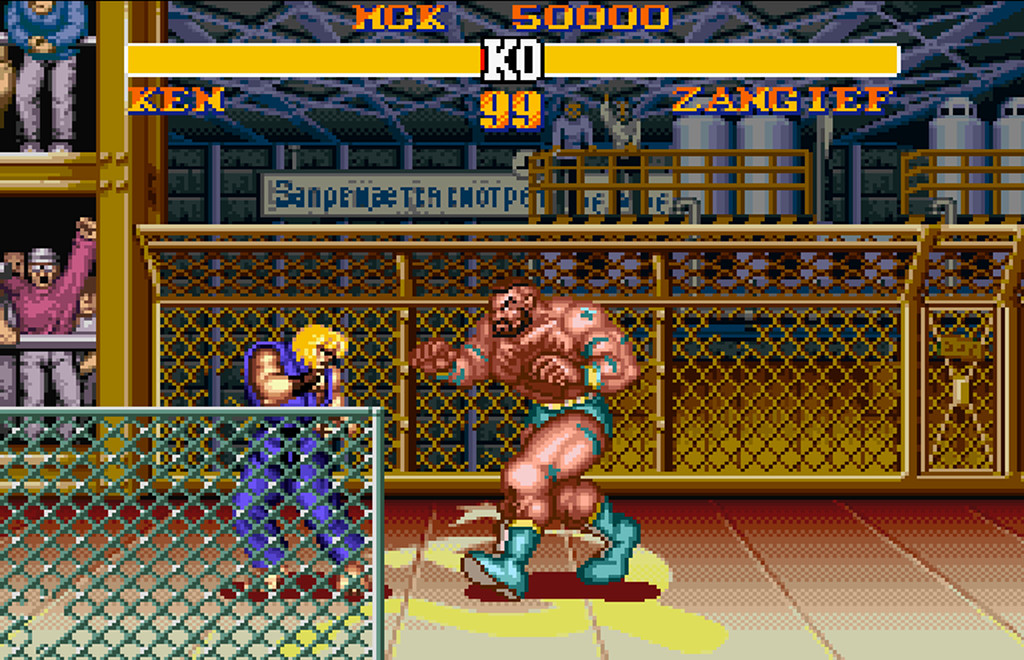 Street Fighter 2 Turbo: the perfect port
Street Fighter 2 Turbo: the perfect port
The game has ended with the players eagerness to control the bosses in the home ports (something possible only in arcades, since the Champion Edition version). And this time the port was even better than the first conversion, with no cuts in voices or anything related, making Street Fighter 2 Turbo in SNES one of the preferred versions until current days. Undoubtedly, it figures as the 9th best selling game in the console.
Another important fact from this time: finally Electronic Arts launched its first game in the console: Bulls versus Blazers.
The never released CD-ROM
During 1993, one casualty for the SNES: the cancellation of the much-anticipated CD-ROM. Sony and Nintendo could not reach an agreement, said to be very supportive of Sony (they’ll have full control over the games released in CD format).
 Sony CD-ROM prototype
Sony CD-ROM prototype
Nintendo then signed a deal with Philips, which released some non quality games for its platform, CD-i using Nintendo characters, with no commercial success.
After this, Nintendo gave up to produce this addon, saying they could not see how the technology will help to improve games from that generation.
Sony then released some games for SegaCD and try to make a deal with Sega about a Genesis successor, but Sega denied too. And after get a negative answer from Nintendo and Sega, we know the result from Sony…
Blood, sweat and tears
Still in 1993, another game started to rival Street Fighter 2 by the fighting gamer preference: Mortal Kombat. Using real actor digitalized images, screams, a lot of blood, and fatalities to finish the opponent, all under a Big Trouble in Little China atmosphere, the game soon became a fever in the Western arcades.
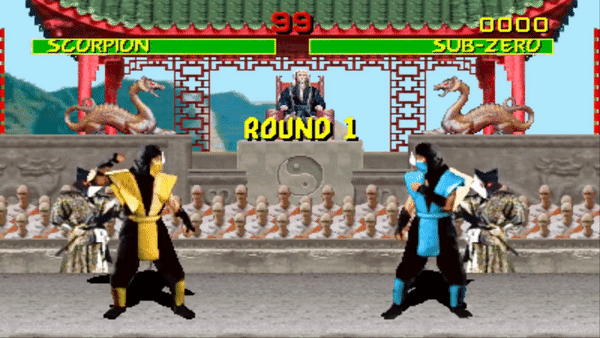 MK arcade: Get over here!
MK arcade: Get over here!
Soon the game was promised to arrive in the home game consoles. The news now is that after Nintendo relax its policy, both consoles would receive their versions simultaneously.
And it happened: few months later, Genesis and Super Nintendo received its ports. With some important differences, that changed not only the Nintendo policies, but even the USA laws.
The SNES version was a very good technical conversion: characters, backgrounds, music and voices were really close to the arcade. But… the game replaced the blood by “sweat”, and all the fatalities were replaced by more light moves.
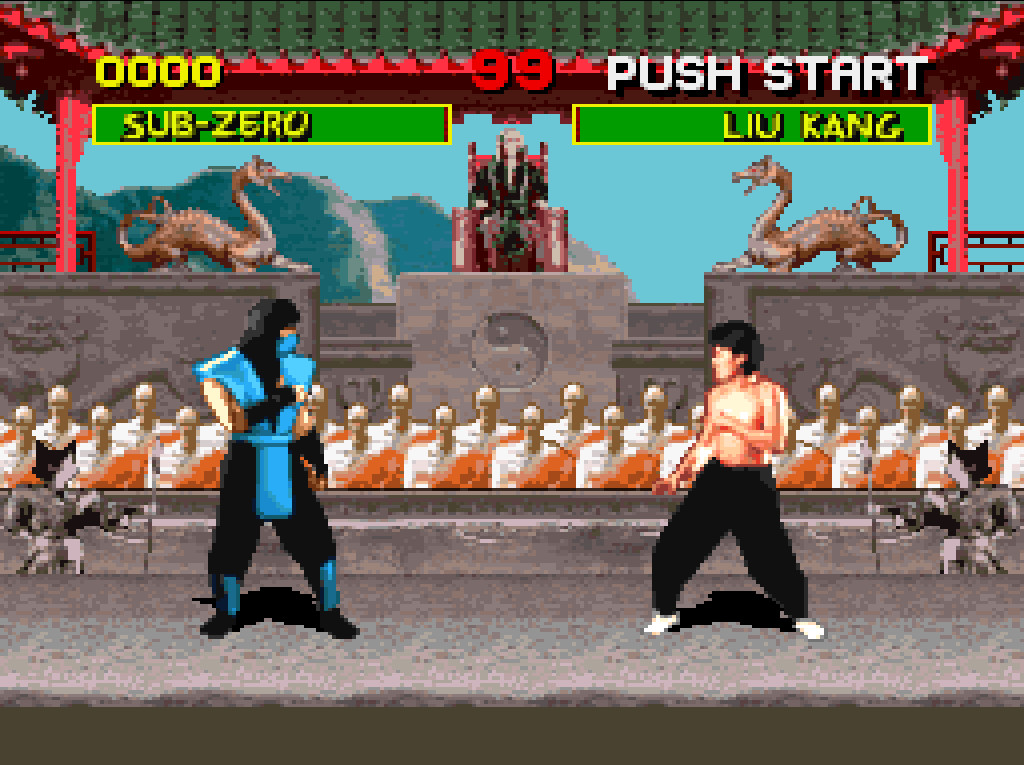 MK on SNES: I’ll drink your… sweat?
MK on SNES: I’ll drink your… sweat?
In the other side, Genesis version was technically poor, with more ugly graphics and several voices missing. But, after the player enter a cheat code, all the arcade fatalities were present.
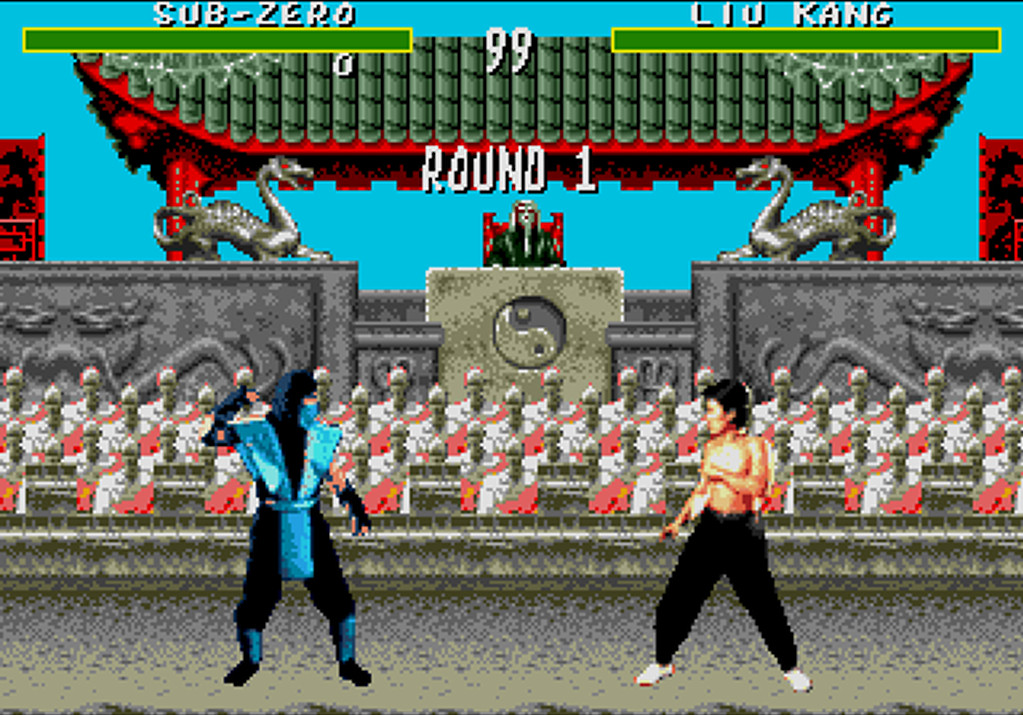 MK on Genesis: I’m going to pull a twine from your back!
MK on Genesis: I’m going to pull a twine from your back!
The sales results is that Genesis port sold almost 4 times more than Super Nintendo one, raising several complains from the players and from Midway (the game developer) against Nintendo and its friendly-games-only policy.
Due Mortal Kombat, the USA government got worried about how the human body got realistic represented in the newest games, like Mortal Kombat (SNES/Mega), Night Trap (SegaCD) e Lethal Enforcers (arcade), compared to the previous games that used cartoon graphics. After several audiences, the ESRB (Entertainment Software Rating Board), was created, requiring that all games were classified in a category according the player age and displayed in the game box.
Still in 1993, SNES received several good games, like Sunset Riders, Super Mario All Stars, Axelay, Battletoads in Battlemaniacs, Rock and Roll Racing, Secret of Mana, Out of this World, not to mention StarFox, that using the SuperFX chip was able to generate polygonal graphics.
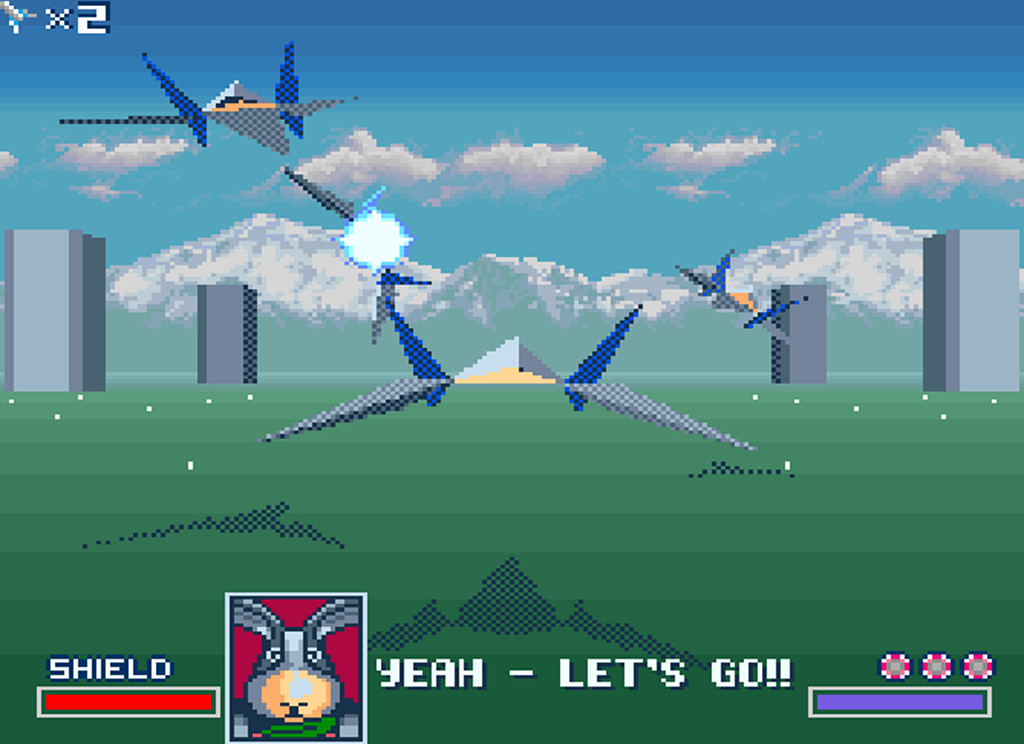 Starfox: Do a barrel roll!
Starfox: Do a barrel roll!
Sega, now with no more Nintendo restriction to the publishers, started to receive several games from the old Nintendo partners, like Konami and Capcom, some of them ports of previously SNES released games, some of them brand new games.
While both consoles were receiving excellent games, and several were released to both platforms, Sega was still using the “childish” (or “slow”) gaming marketing.
The second Blast Processing advertisement
But then we reached 1994…
1994: blood and bananas
In 1994, both systems received several awesome games, including simultaneous versions, like Earthworm Jim, NBA Jam, Flashback, Aladdin (different versions produced by different companies) and some NeoGeo conversions, like Fatal Fury 2, Samurai Shodown and others.
SNES still received other amazing games, like Mega Man X and a game that is considered by many the best generation game: Super Metroid. Tecnically very well made, long gameplay, and now presenting a map (an improvement when compared with previous games in older generations). Now the game saves the player progress too, perfectly recreating the Alien movie atmosphere. The game mechanics (giant map, suite improvements that are unlocked during the progress, backtracking) created a game style that was cloned by several games after it. This game style is known today as Metroidvania, as all Castlevania games in the later generations used this mechanics.
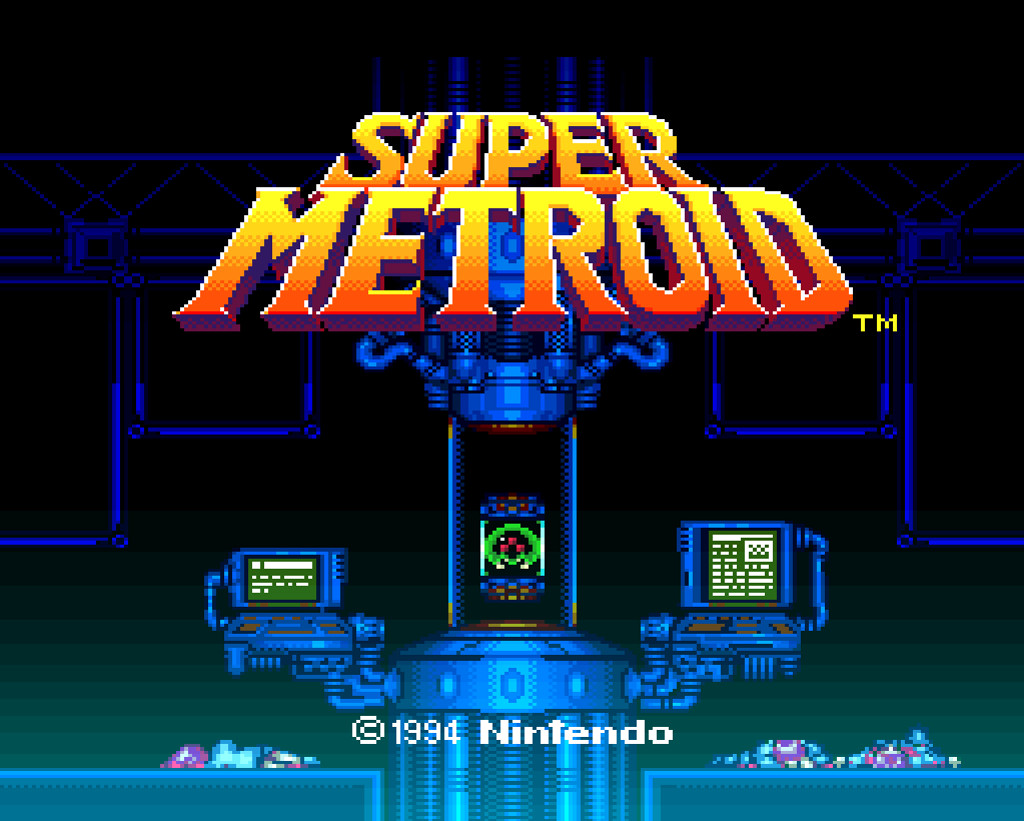 Super Metroid and its harrowing music!
Super Metroid and its harrowing music!
Sega was already announcing their new platforms during this year: Sega Saturn, the Genesis sucessor; and an another Genesis addon, the 32X, which will allow 32 bits games custom made for it (no Sega Saturn compatibility). Sega of America didn’t like the 32X idea, but Sega of Japan mentioned to be afraid of… Atari Jaguar, because it’d be the first next generation console to be launched.
The battle for the generation was still, in some sense, tight, but then Midway announced the release for a home port of Mortal Kombat 2.
The Genesis version improved a lot when compared with the first poor port: the graphics were much more close to the arcade (still missing few elements and one secret background), and it has more voices then the first version (still, several voices missing).
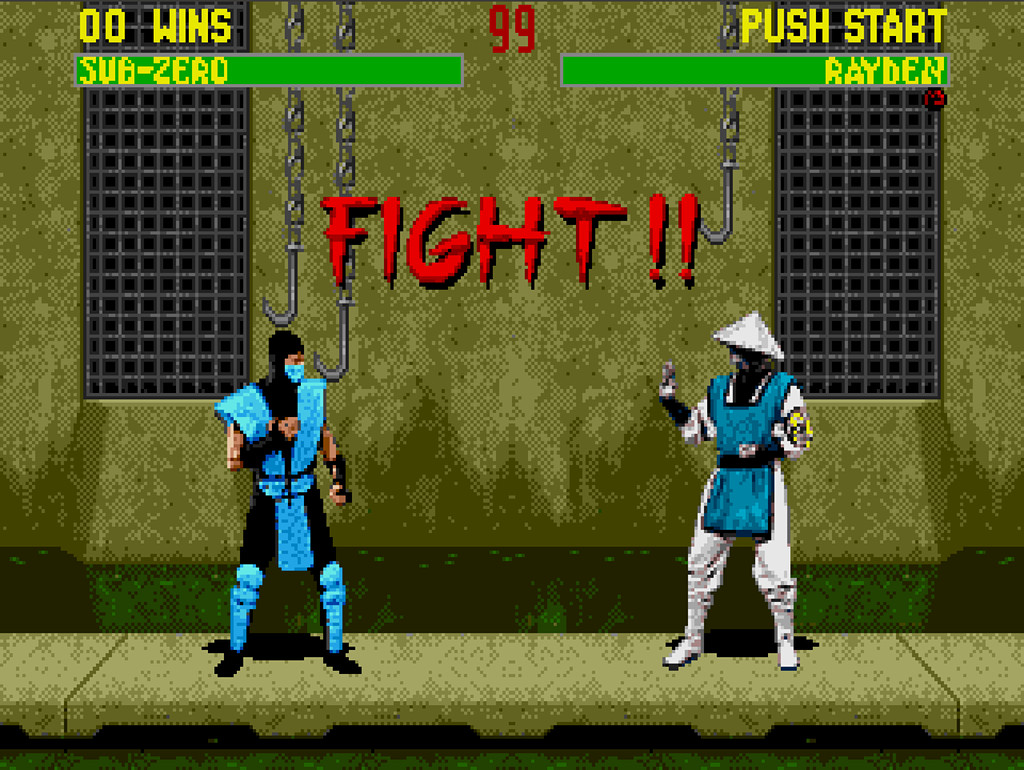 MK2 on Genesis: a better port then the first version
MK2 on Genesis: a better port then the first version
But the show was in the Super Nintendo version. This time, only one minor difference for the arcade: the character name was not in the lifebar. Blood, fatalities, all the voices, the playability, backgrounds (even the secret one), even the big characters, all present! This time, not a fair comparison: Super Nintendo version for Mortal Kombat 2 was simply better in every aspect and a perfect arcade port!
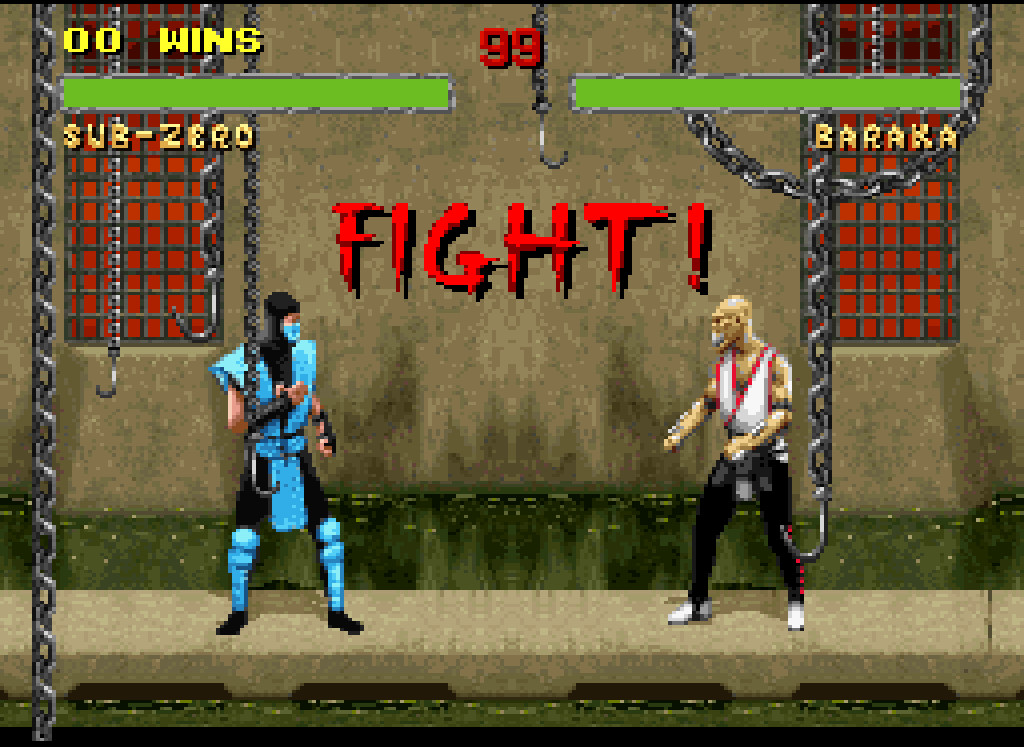 MK2 on SNES: the arcade at home!
MK2 on SNES: the arcade at home!
In June of the same year, it happened the CES 94 (Consumer Electronics Show), where Nintendo built huge booths to announce its new game, Donkey Kong Country. The monkey, which appeared only as villain in the previous Atari game Donkey Kong, now would be the new star, and with style: the game would rely on 3D graphics generated by 64 bits graphical workstation from Silicon Graphics. Something surreal for the 16 bits!
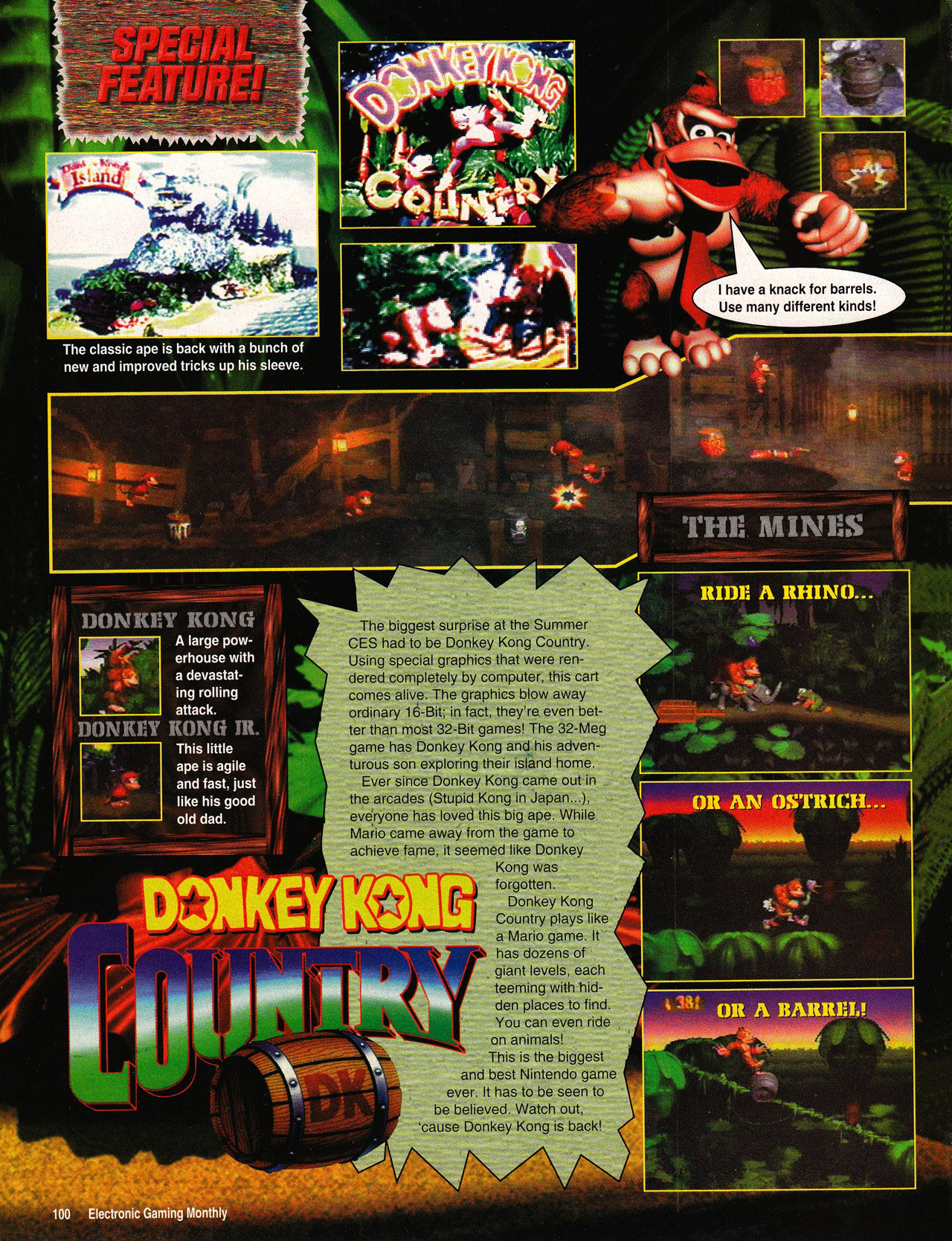 EGM #61 and the Donkey Kong preview (EGM Aug/94)
EGM #61 and the Donkey Kong preview (EGM Aug/94)
The game repercussion at CES was so huge that obfuscated the next gen consoles announcements (Sega Saturn and Sony PlayStation, to be released in the next year). Nintendo, in the other hand, mentioned that SNES still have power enough to keep the gamers interested (which was clear with Donkey Kong) and that its sucessor will be, maybe, be released in 1995 end.
While awaiting for the game, the RPG master piece was released in October: Final Fantasy III (western version of Final Fantasy VI). The game was a milestone in the RPG world, considered by IGN magazine until current days the best RPG of all times. Different from all RPG from that time, the game used the steampunk theme, instead of the medieval one. It’s music track used orchestrated music and the story is considered the best one in the series (due the charisma, several plot twists and the epic ending). The translation from the Japanese was considered fine (on that time, most of them were terrible).
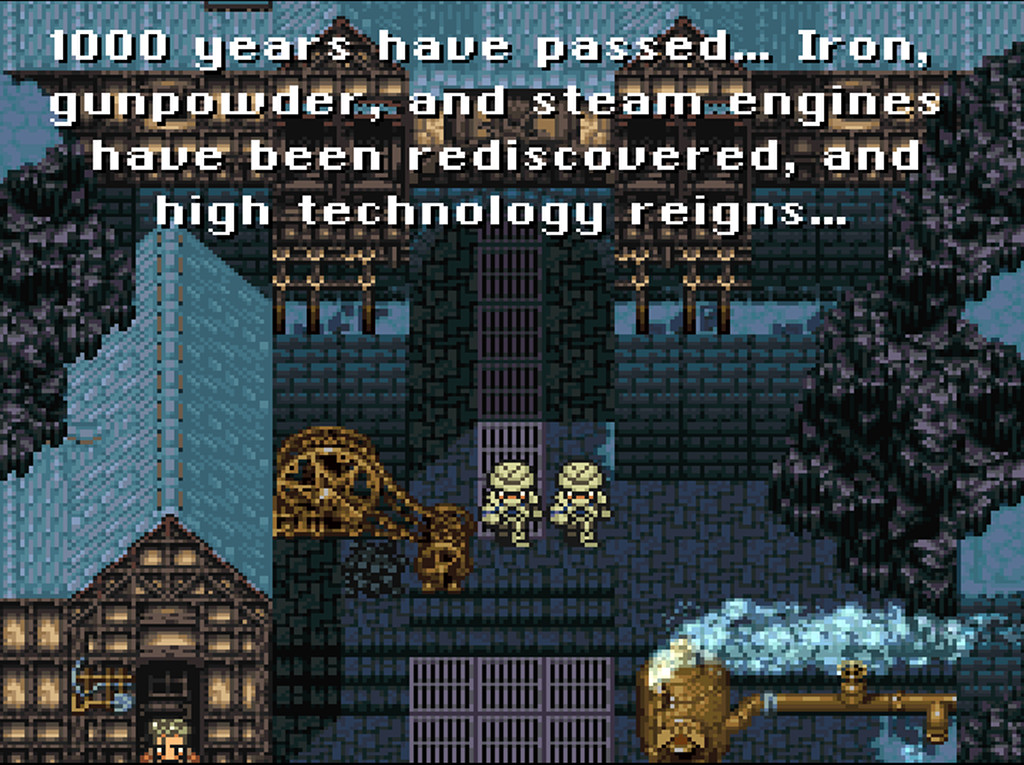 Final Fantasy: sorry PlayStation, but 6 is better than 7!
Final Fantasy: sorry PlayStation, but 6 is better than 7!
And as if it were not enough, in 1994, Nintendo, again in partnership with Rare, released an arcade game that many didn’t believe Nintendo would launch: Killer Instinct. The game, published by Midway (responsible by Mortal Kombat series), was based in a creatures fighting tournament. Aside the dark environment and the advanced graphics (using the Rare 3D modeling techniques), the game not only was using the Street Fighter script, but it has fatalities (as Mortal Kombat) and inovated with a combo system. Instead of best of 3 rounds, the winner would be the fighter whom beat the oponent life two times. The arcade became a instant hit, to the point of eclipse, in arcades, Mortal Kombat 2.
KI on arcades: Ultra Combooooo!
In November of 1994, Donkey Kong Country release month, Nintendo Power subscribers received a VHS tape with a making off from the game: this time Nintendo would not loose the strike back.
With a US$ 3.76 million marketing campaign and the Play it Loud slogan, the announcement in the VHS was clearly poking the competition, where after show the technical aspects of Donkey Kong production comes the question Where you gonna find it?. Followed by the tips: Not in 32 bit, Not in 32X adaptors, Not on CD-ROM, Not on Sega; and the answer: It's 16 bit and It's only on Super NES.
Donkey Kong Country Exposed (1994): skip to 11m42s
Finally launched at Nov, 21, 1994, the game broken the fast selling game record until that time: only until the year’s end, it sold more than 6 million units. Historically, it’s the 3rd best selling game in the console, right after Super Mario World and Super Mario All Stars.
1995: It’s all yours, Nintendo!
If Donkey Kong Country made an excellent year start for Nintendo, Sega was not able to give any reasonable response, because it barely was able to keep Mega Drive, Sega CD, 32X, GameGear and Master System, basically producing few games (or not games at all), as it was preparing the next console launch, Sega Saturn.
In January, a sad memory for the SNES owners: at Winter CES, Nintendo shown several new Super FX games, like FX Fighters and StarFox 2, games never released due the imminence of the next Nintendo console launch.
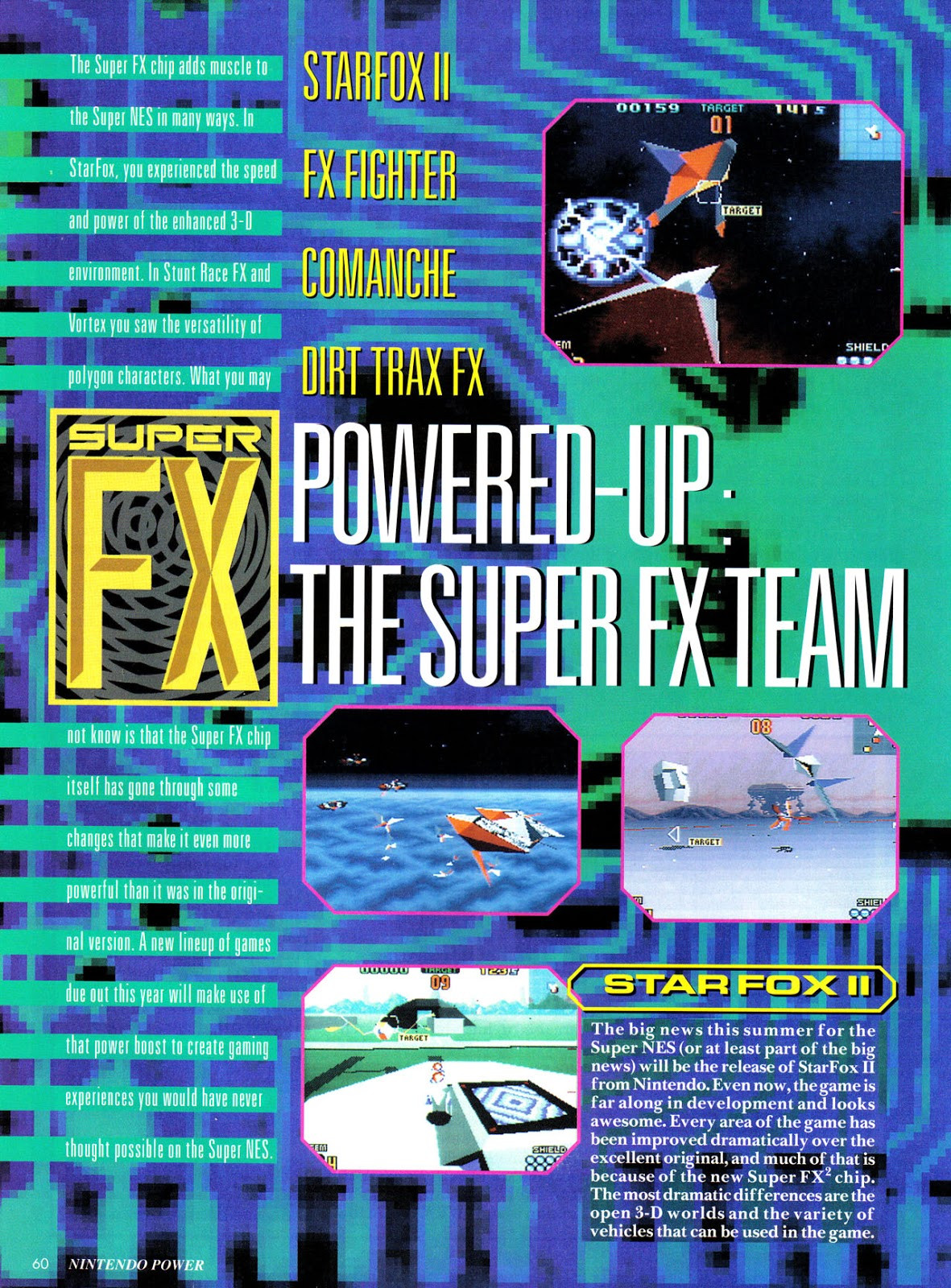 Nintendo Power #69 (Jan/95) made an SuperFX special: StarFox2 (canceled)…
Nintendo Power #69 (Jan/95) made an SuperFX special: StarFox2 (canceled)…
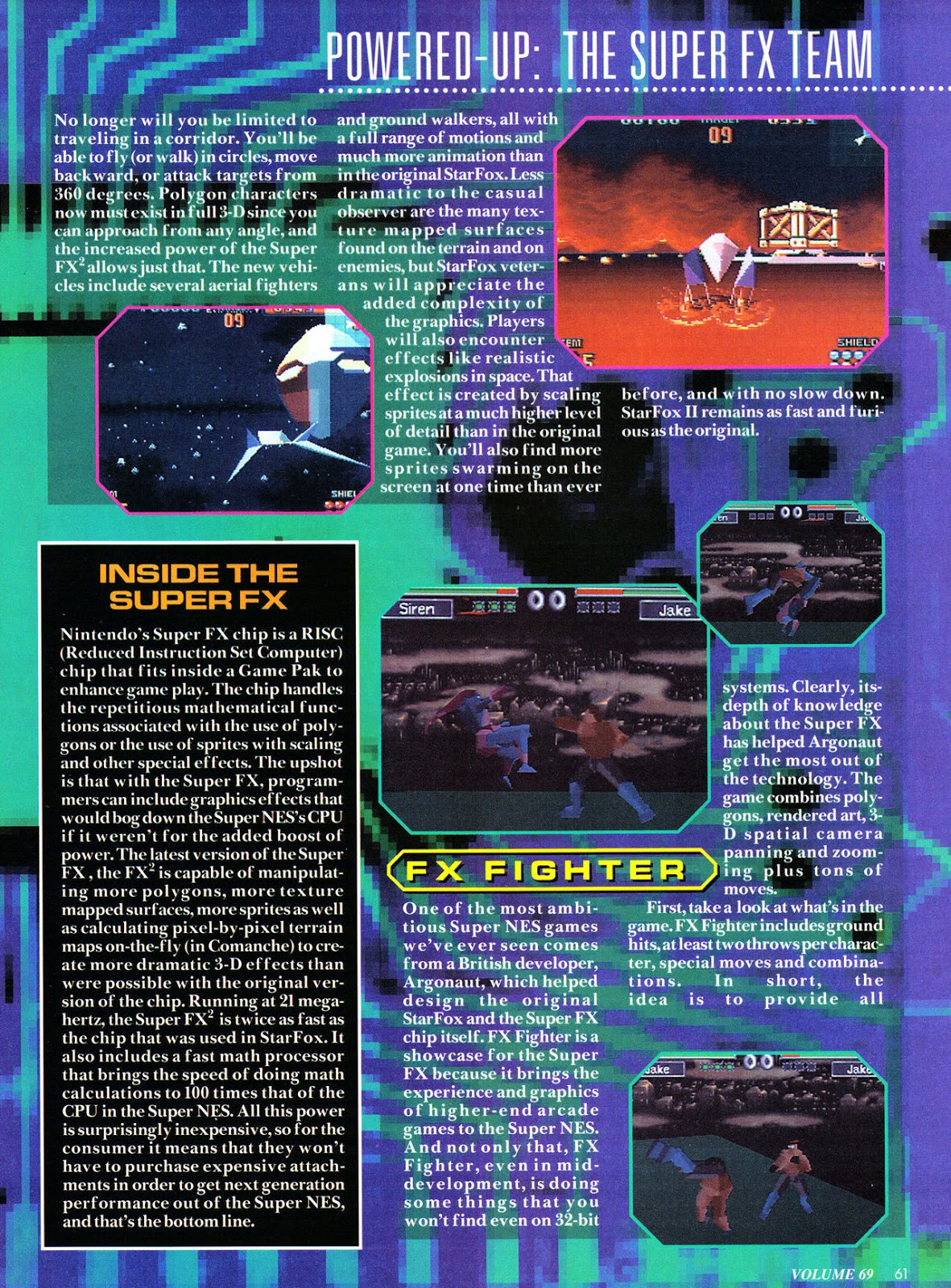 … FX Fighters (released only on PC)…
… FX Fighters (released only on PC)…
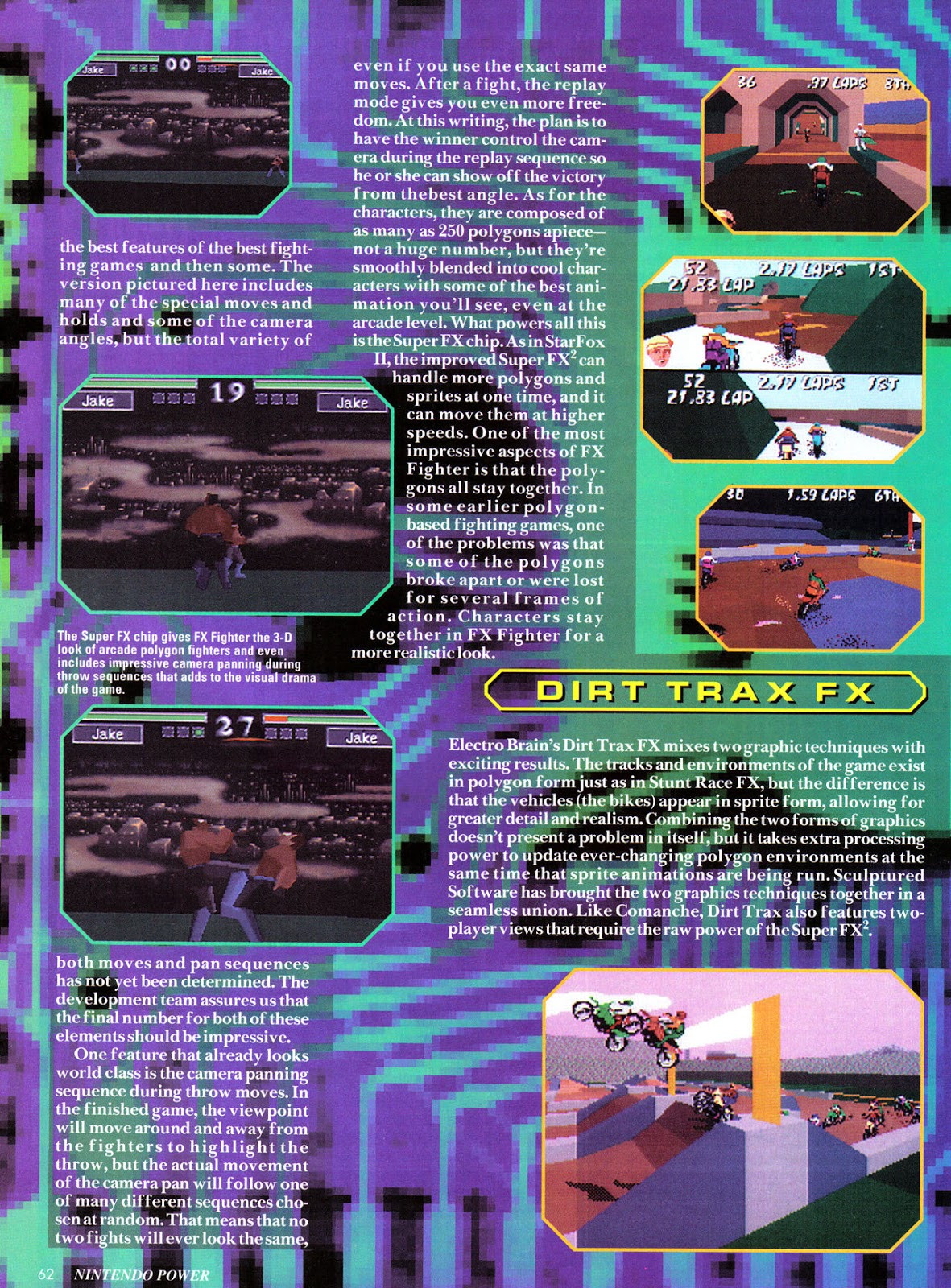 … Dirt Trax FX (the only one released on SNES)…
… Dirt Trax FX (the only one released on SNES)…
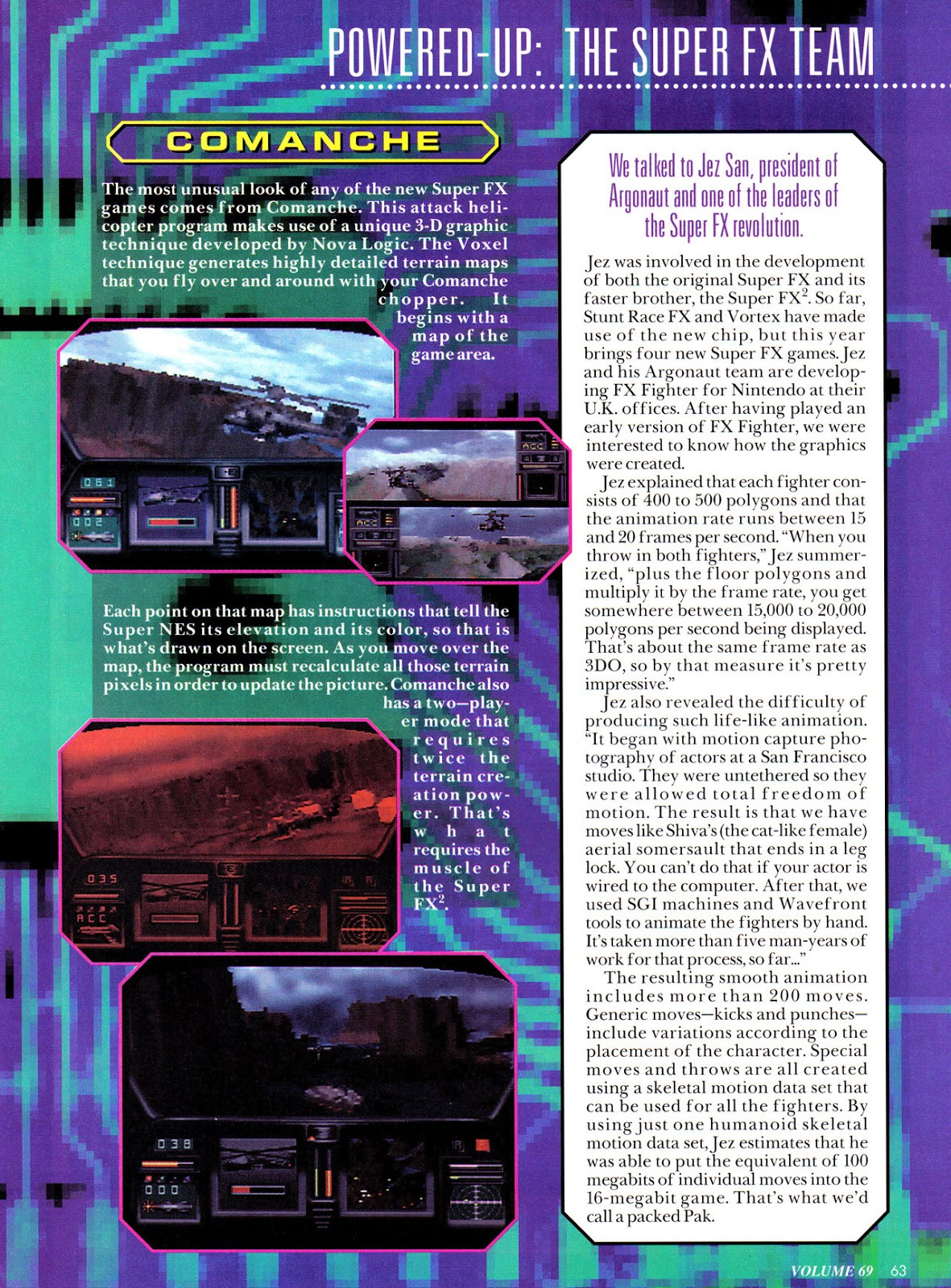 … and Comanche (released only on PC too).
… and Comanche (released only on PC too).
Out of curiosity, StarFox 2 will be available in the list of selected games for the Super Nintendo Classic (September, 2017).
In May, it happened the first E3 (Electronic Entertainment Expo), as CES was a mix of videogames and other electronics. In this first edition, several announcements that sealed the gaming market future.
Sega of America, again unwillingly and by command of Sega of Japan, announced the Sega Saturn immediately available (instead of the earlier announced date, at September), surprising not only the customers, but mainly the big stores and partner developers. Sony, seeing this Sega embarrassment, announced that its PlayStation would now cost US$ 100 less than Sega Saturn (available at US$ 400).
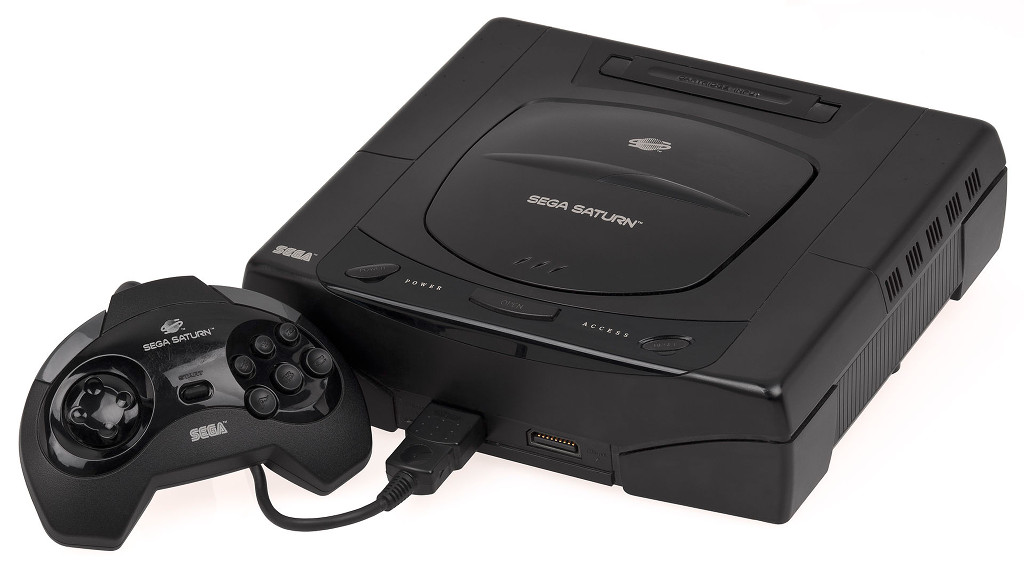 Saturn: the new Sega console (by Evan-Amos)
Saturn: the new Sega console (by Evan-Amos)
Again, Nintendo was the main star, announcing a sequel do DK, Donkey Kong Country 2 and a port of its arcade hit, Killer Instinct!
In June, one of the most loved game by the soccer fans: International Superstar Soccer. The game was a step further for the 16 bits: characters using a more real scale, different skin colors, narration, sounds of the crowed, and the progress could be saved (using an internal battery). Two points are remarkable in the fans memories: the fake players names used in the game and hacked versions released in several countries with local championships.
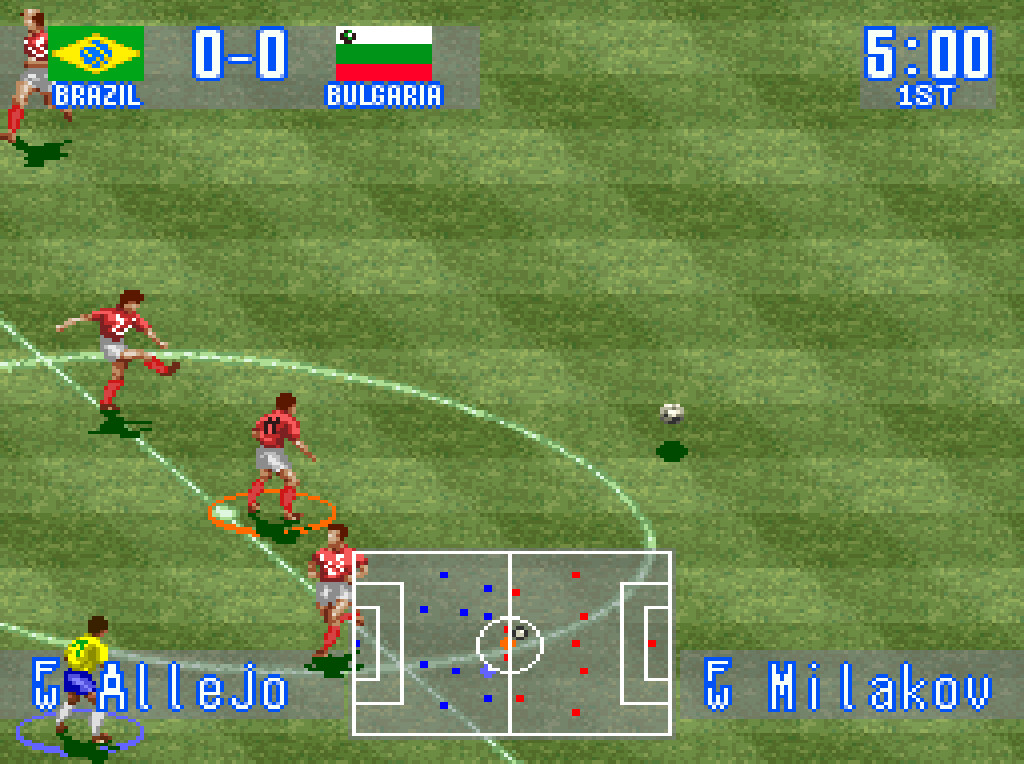 Romario, Ronaldo, Neymar? No way, Allejo is the best!
Romario, Ronaldo, Neymar? No way, Allejo is the best!
At the beginning of September, Sony released its brand new videogame, the PlayStation, which sold, in 1995, 800 thousand units, more than Sega Saturn, but a way less than the 16 bits consoles sold that year.
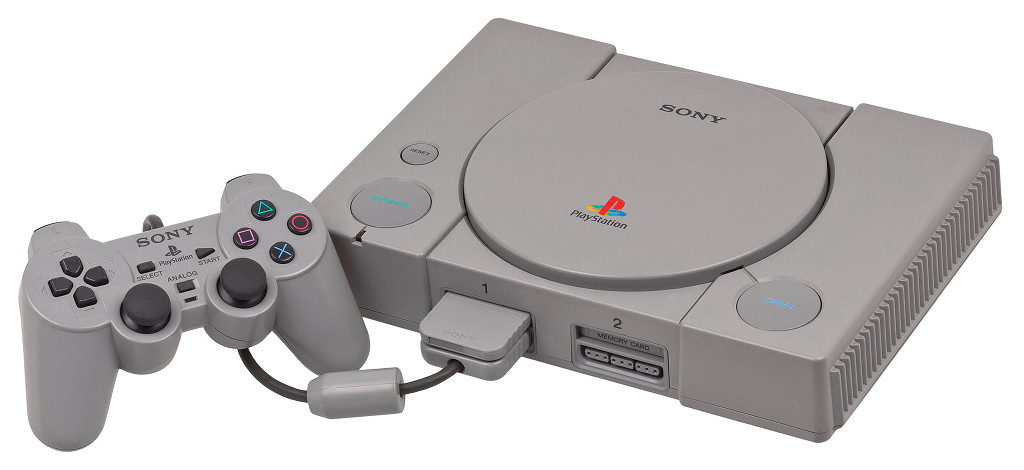 The first Sony videogame: the PlayStation (by Evan-Amos)
The first Sony videogame: the PlayStation (by Evan-Amos)
At the end of September, Killer Instinct was released, in a beauty black cartridge, and the first 100 thousand copies were packaged with a CD, titled Killer Cuts, with a reworked game soundtrack, including several new musics. as músicas inéditas.
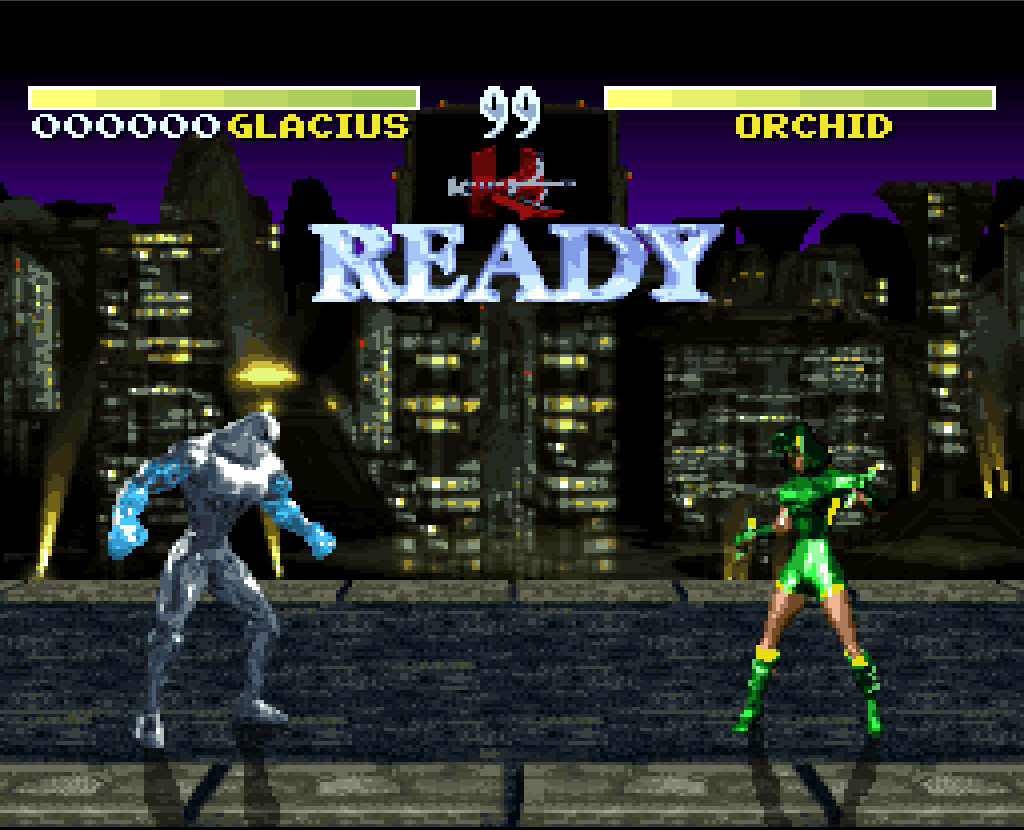 SNES Killer Instinct port…
SNES Killer Instinct port…
… and the Killer Cuts CD (The Instinct track)
In this meanwhile, the system still received Chrono Trigger, developed by a team formed by Square and Enix stars (called the Dream Team), making Super Nintendo definitely the best RPG console in the history.
Nesse meio tempo, o sistema ainda recebeu Chrono Trigger, desenvolvido em conjunto por integrantes da Square e Enix (na época, apelidados de Dream Team), fazendo com que o Super Nintendo fique definitivamente na história como o melhor console para RPGs.
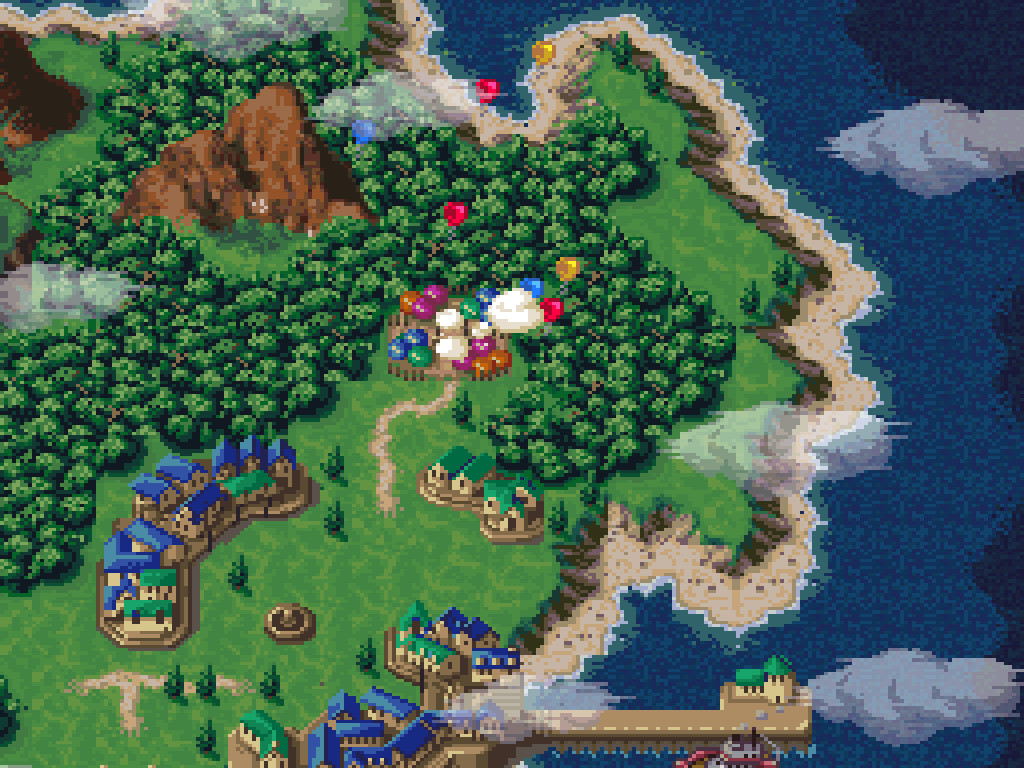 Chrono Trigger: the party is already running and you, sleeping in your bedroom…
Chrono Trigger: the party is already running and you, sleeping in your bedroom…
Still in September, Sega of Japan made another movement that contributed to kill Sega of America success: they ordered that only Sega Saturn would receive new games. As results, in the next year, the Sega of America CEO leave the company, for obvious reasons.
In October, another cartridge showing the console muscles: Super Mario World 2: Yoshi's Island, which was using the SuperFx evolution, the SuperFX2. Thanks to it, Yoshi's Island is one of the most beauty games in the 16 bits, using graphics that appears to be drawn with crayons, along with zoom and rotation effects. The chip is so powerful that even today, the most powerful retrogaming flash cards cannot reproduce it without a huge cost. The game still served as base for other games from the tiny dinosaur, like Yoshi's Woolly World for WiiU.
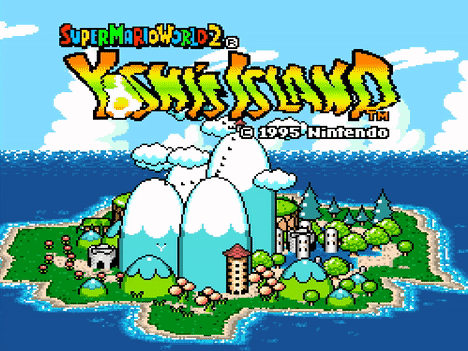 Yoshi Island: one of the most beauty games from the generation!
Yoshi Island: one of the most beauty games from the generation!
In November, Donkey Kong Country 2 came out, with better controls and the piracy theme (considered by some players the best in the series). Nintendo substimated the game demand, and at the end of that year, some stores got the cartridge sold out. Stores like Toys R Us had to implement a reservation system to try to handle all Christmas orders.
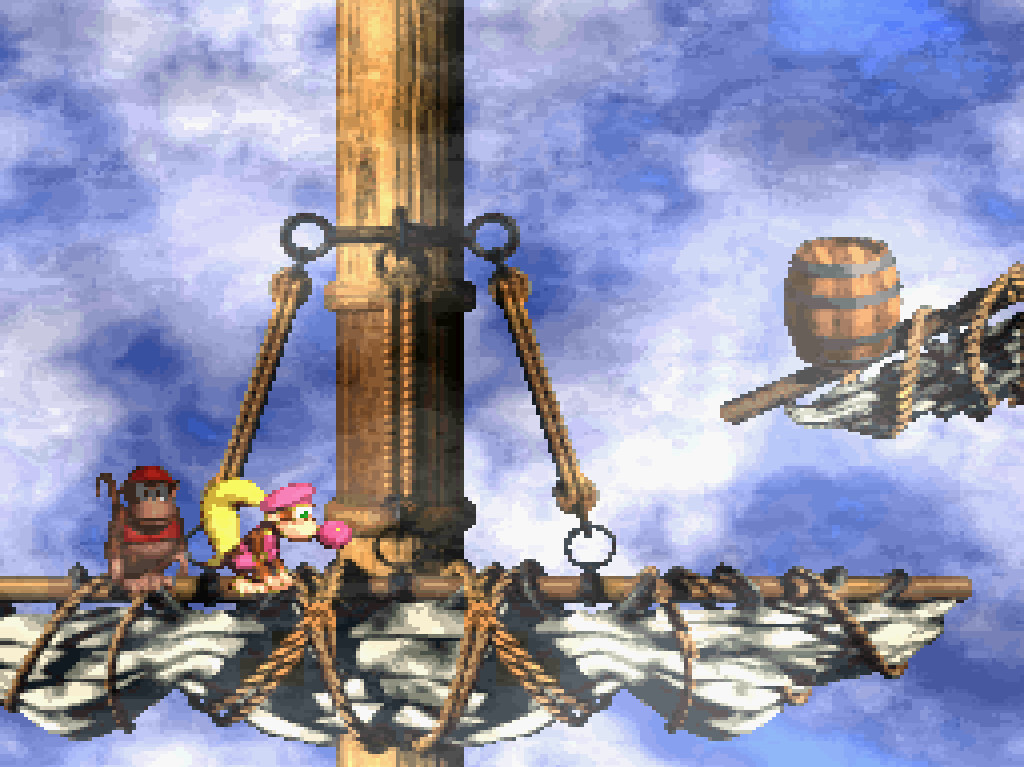 Donkey Kong Country 2: improved mechanics and more responsive controls
Donkey Kong Country 2: improved mechanics and more responsive controls
Without the main competitor, relying on awesome games, and next-gen consoles still starting their lives, Nintendo was responsible, in 1995, for 42% of the spent dollars in the game market in the USA. Relying only in Super Nintendo: no next-gen console, no addons.
But… as nothing last forever, at November in Japan, the company displayed the final shape of the Super Nintendo successor, planned to be released in the following year, the Nintendo 64.
1996: A worthy year
Now with all the attention focused in its successor, in 1996 the SNES received less games, but almost all of them high quality releases.
In the beginning of the year, we had Earthworm Jim 2, Final Fight 3 and Mega Man X3.
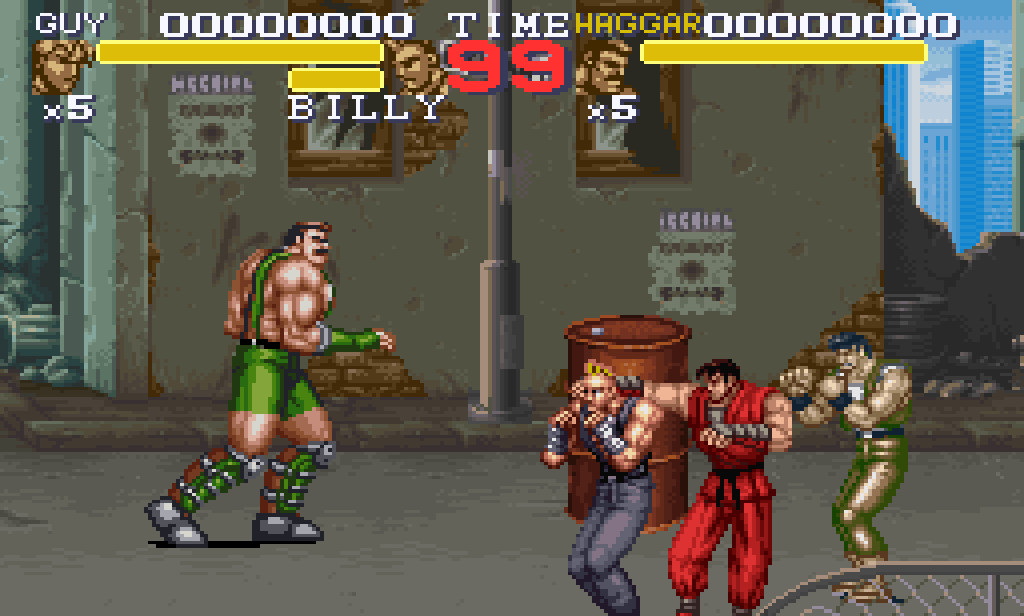 Final Fight 3 had even a CPU co-op mode!
Final Fight 3 had even a CPU co-op mode!
In May, once again using the rendering techniques used in Donkey Kong, we had the wonderful Super Mario RPG: Legend of the Seven Stars, made by Square, and more then awesome graphics, it had a soft humor, glad history and it mixed turn RPG with action elements typical from Mario games.
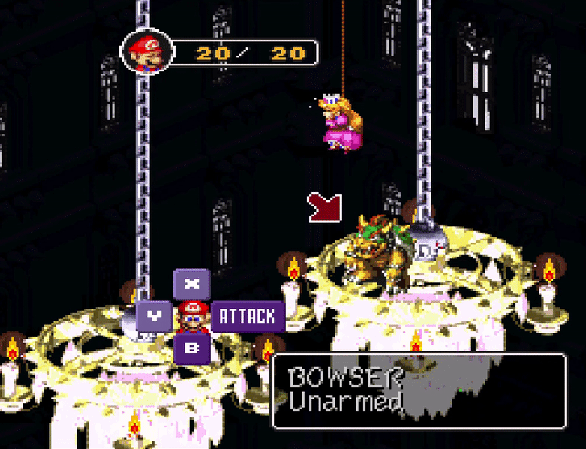 Sounds like, but this time is not about only save the princess!
Sounds like, but this time is not about only save the princess!
In June, the console received its last Mortal Kombat edition, Ultimate Mortal Kombat 3. The game was a port from the arcades, which, by its turn, was a second iteration over Mortal Kombat 3, adding back some fighters missing from the previous version, like Scorpion and Johnny Cage. Furthermore, the 16 bits version received Noob Saibot and Rain, fighters not present in the arcades, only in later versions, like Mortal Kombat Trilogy, available for next-gen consoles - a tribute to the 16 bits. The game has a total of 25 characters, a record for that generation.
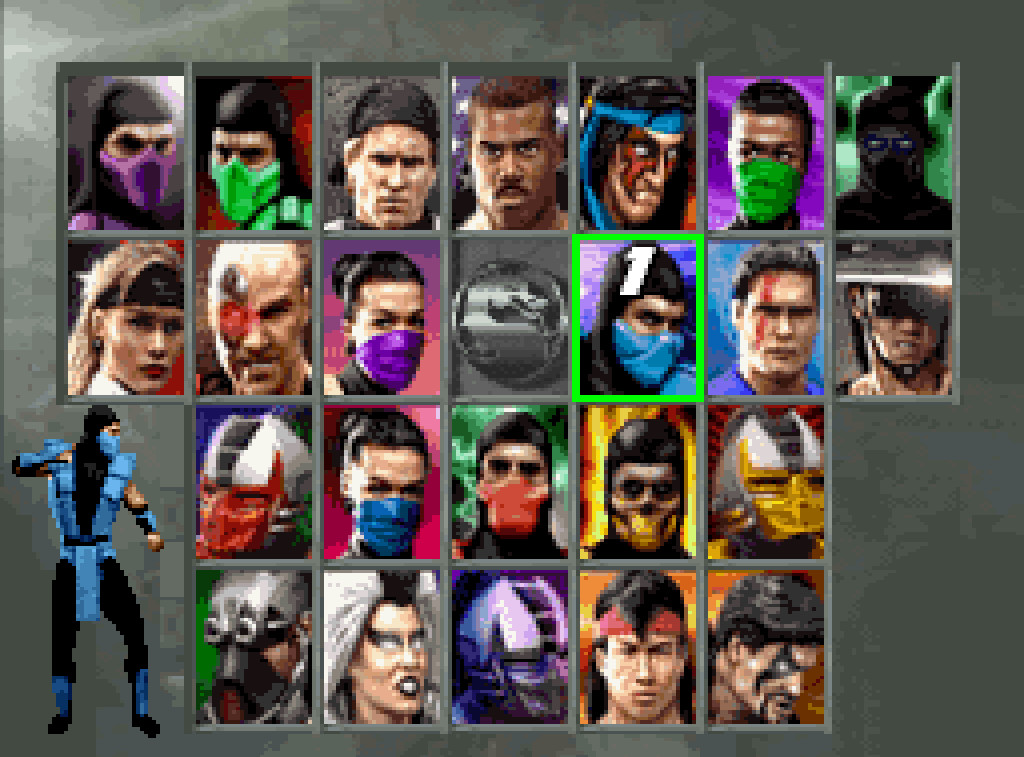 UMK3: a fighter for every taste
UMK3: a fighter for every taste
Still in the end of June, Nintendo finally released the Nintendo 64 in Japan. In September, the console arrive in the North America, with Super Mario 64 and Pilotwings 64. Like the SNES, the console still uses cartridges, the only one in the next generation. From now, all the Nintendo attention was on it, because this year the PlayStation was hit in the market.
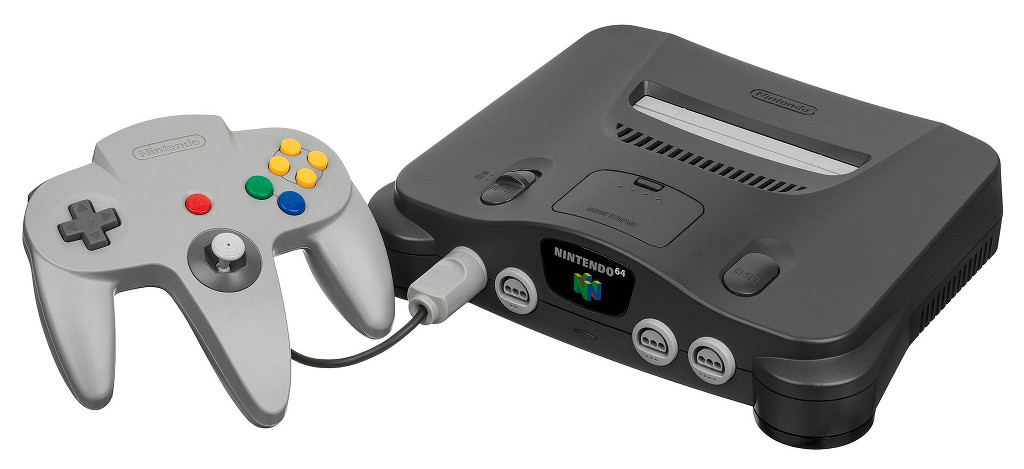 The SNES successor: the Nintendo 64 (by Evan Amos)
The SNES successor: the Nintendo 64 (by Evan Amos)
In the beginning of November, Super Nintendo saw an expected game release: a port of Street Fighter Alpha 2, from Capcom. This game, until that moment, was available only for Sega Saturn and PlayStation. The port presented a curious loading screen, something never seen in cartridge games. The reason: as the game would use more memory than supported by SNES cartridges, Capcom used compression to make the graphics fits on it. Then, before the fight starts, the S-DD1 chip would decompress the graphics and load them in the system memory.
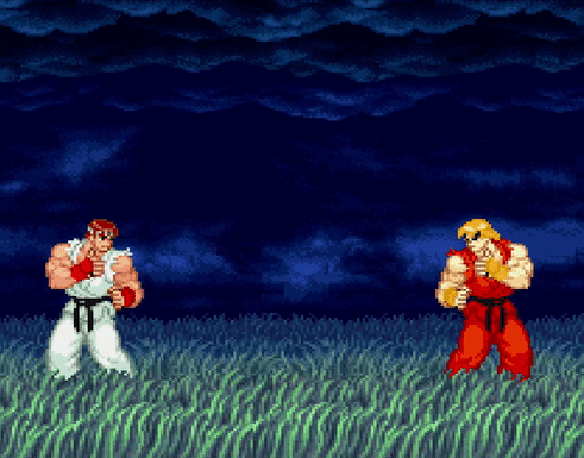 SF Alpha 2: a next-gen game on Super Nintendo!
SF Alpha 2: a next-gen game on Super Nintendo!
And as year’s end tradition, at the November ending, we saw the release of Donkey Kong Country 3, which added some RPG and strategy elements to the game, increasing a bit the difficulty, like in the first game.
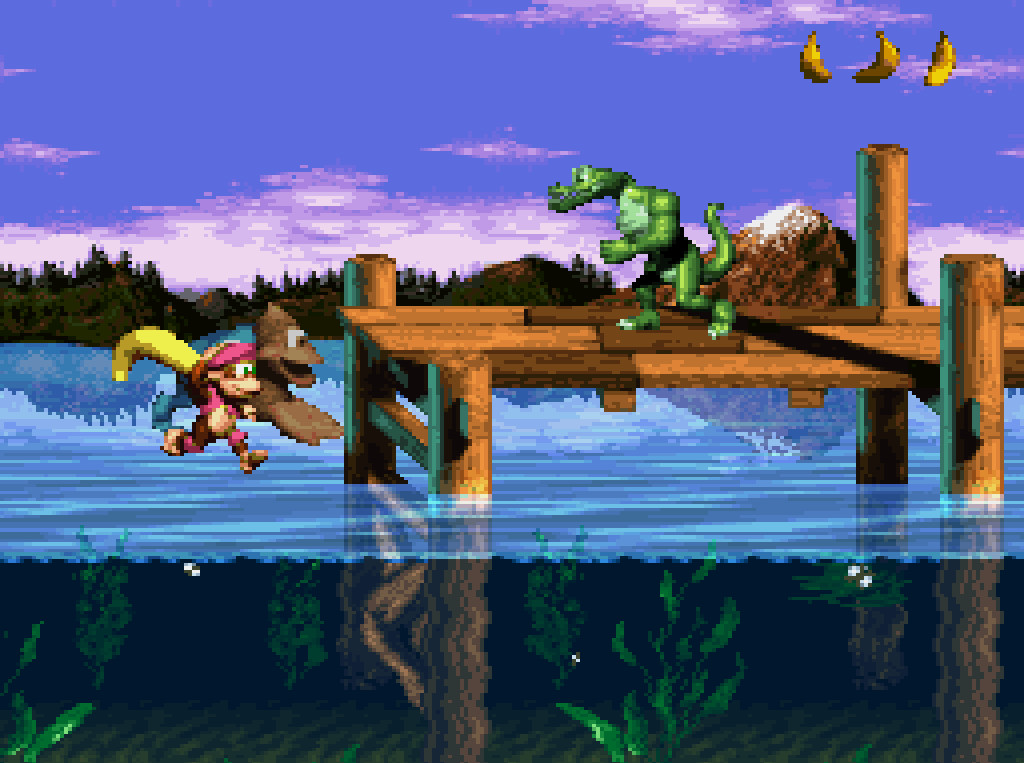 Donkey Kong Country 3: the last DK for Super Nintendo :(
Donkey Kong Country 3: the last DK for Super Nintendo :(
1997: Good bye, big boy!
In 1997, by a ironic destiny, the console basically received only the Electronic Arts anual franchises, which by the way were the same games from the previous years with small (or none) improvements, just to make some numbers from the big installed base: NBA Live 98, NHL 98, FIFA: Road to World Cup 98 e Madden NFL 98 (yeap, all using 98 at the name, but all launched in 1997).
The last game released by Nintendo to the SNES was Kirby's Dream Land 3, in November of 1997, a remake from Kirby's Dream Land for the GameBoy hand held.
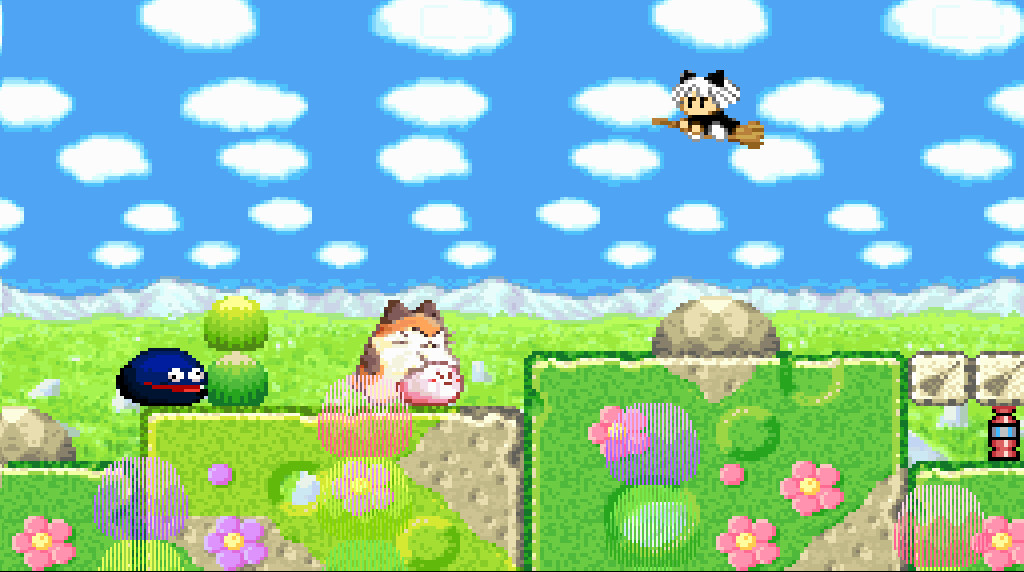 The extremely colorful Kirby’s Dream Land 3
The extremely colorful Kirby’s Dream Land 3
During this year, Nintendo released too the second Super Nintendo model, the SNES-101, as known as SNES Jr, which was smaller, missing Eject button and only with A/V output.
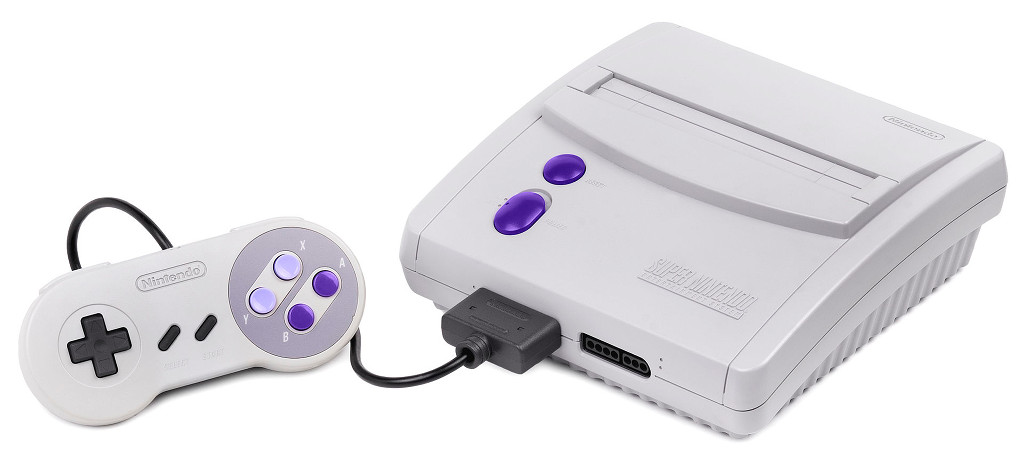 The SNS-101 mode, or, for the friends, SNES Jr. (by Evan Amos)
The SNS-101 mode, or, for the friends, SNES Jr. (by Evan Amos)
Interestingly, the Japanese version, the Super Famicon Jr, was more pretty then the American version (this one designed by Lance Barr again), with an elegant white and the colored buttons.
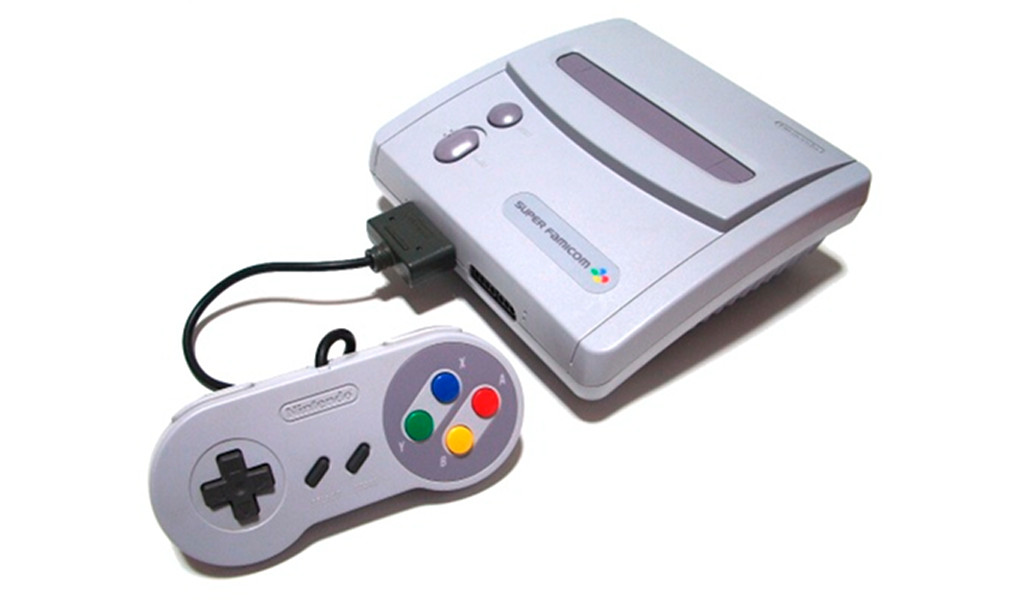 A lot of style in the SFamicom Jr with white color and colorful gamepad! (by Muband)
A lot of style in the SFamicom Jr with white color and colorful gamepad! (by Muband)
In the USA, the console said goodbye in October of 1998, receiving a single game during all the year, Frogger (yes, that one, the crossing street frog game).
In Japan, the console still received new games until 2000, and was made until September of 2003, curiously more than 1 year later than that Nintendo 64 stopped being made.
